First Computer GE3A MINI PC User Manual
First International Computer Inc MINI PC
User manual
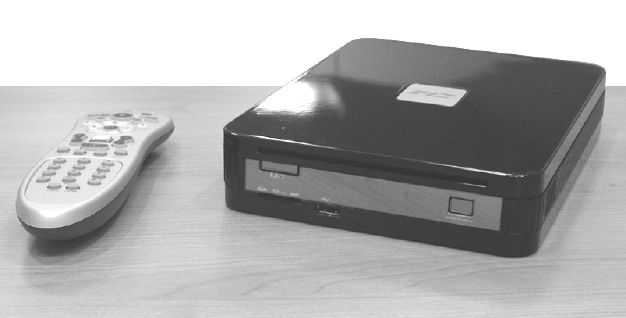
GE3 Mini Entertainment PC
User Guide

Mini EPC USER GUIDE
2
Copyright©2008
All Rights Reserved - Printed in Taiwan
GE3 Mini EPC User Guide
Original Issue: 2008/02
This manual guides you in setting up and using your new mini EPC.
Information in this manual has been carefully checked for accuracy
and is subject to change without notice.
No part of this manual may be reproduced, stored in a retrieval
system, or transmitted, in any form or by any means, electronic,
mechanical, photocopy, recording, or otherwise, without prior written
permission.
Trademarks
Product names used herein are for identification purposes only and
may be the trademarks of their respective companies.
Microsoft, Windows Vista, and Windows Sound System are
trademarks of Microsoft Corporation.
Intel ®, Intel ® CoreTM 2 Duo, Intel ® Celeron ®, and Intel ® HD
Audio (Azalia) are registered trademark of Intel Corporation.
All other brands or product names mentioned in this manual are
trademarks or registered trademarks of their respective companies.

Mini EPC USER GUIDE
3
FCC Information to User
Safety and Care Instructions
No matter what your level of experience with computers, please
make sure you read the safety and care instructions. This information
can help protect you and your computer from possible harm.
Important Safety Instructions
This section gives you detailed information about how to maintain a
safe working environment while using the Notebook (Laptop). You
can maintain its condition and performance by following these
guidelines. Please read it carefully to ensure maximum safety.
1. Please read these safety instructions carefully.
2. Please keep this manual for later reference.
3. Please keep this equipment from humidity.
4. Do not use this product near water, for example, near a bathtub,
wash bowl kitchen sink or laundry tub, in a wet basement or near
a swimming pool.
5. Avoid using a telephone (other then a cordless type) during an
electrical storm. There may be a remote risk of electric shock from
lightning.
6. Do not use the telephone to report a gas leak in a vicinity of the
leak.
7. Lay this equipment on a reliable surface when install. A drop or
fall could cause injury.
8. All cautions and warnings on the equipment should be noted.
9. Do not operate the Notebook (Laptop) with the cover removed.
For safety reason, the equipment should only be opened by
qualified service personnel.

Mini EPC USER GUIDE
4
10. Always disconnect all telephone lines & all power cords from the
wall outlet before servicing or disassembling this product. To
reduce the risk of personal injury from electrical shock or hot
surfaces, disconnect the power cord from the wall outlet, and
allow the internal system components to cool before touching.
11. Refer your system for servicing to qualified service personal under
the following conditions:
z When the power cord or plug is damaged or frayed.
z If liquid has been spilled into the product.
z If the product has been exposed to rain or water.
z If the product does not operate normally when the operating
instructions are followed. Adjust only those controls that are
covered by the operating instructions, since improper
adjustment of other controls may result in damage and will
often require extensive work by a qualified technician to
restore the product to normal condition.
z If the product has been dropped or the cabinet has been
damaged.
z If the product displays a distinct change in performance, it
indicates a need for service.
z If the equipment has obvious sign of breakage.
12. Refer your system for servicing to qualified service personal under
the following conditions:
13. The unit can be operated at maximum ambient temperature of
35ºC.
14. Li-Ion battery is vulnerable, do not charge it with other power
adapter, or it may cause fire or explosion
15. This product should be operated from the type of power indicated
on the marking label. If you are not sure of the type of power
available, consult your dealer or local power company.

Mini EPC USER GUIDE
5
16. Use only a power adapter approved for use with this Notebook
(Laptop).
17. Do not install near any heat sources such as radiators, heat
registers, stoves, or other apparatus (including amplifiers) that
produce heat.
18. If the Notebook (Laptop) is not in use for a long time, disconnect it
from mains to avoid possible damage by transient over-voltage.
19. The risk of ignition caused by small metallic objects, such as
paper clips or staples, moving around inside TRANSPORTABLE
EQUIPMENT during transportation shall be reduced objects
entering the equipment, please do not remove dummy card from
the product.
For Safety Regulation:
z Risk of explosion if battery is replaced by an incorrect
type.
z For electrical safety concerns, only use telephone cables
rated 26AWG or higher.
z The Optical drive is a Class 1 Laser Product.
z Li-Ion battery is vulnerable, do not charge it with other
power adapter, or it may cause fire or explosion.
z For the power supply of this equipment,
An approved power cord has to be used.
Make sure the socket and any extension cord(s) you
use can support the total current load of all the
connected devices.
Before cleaning the computer, make sure it is
disconnected from any external power supplies (i.e. AC
adapter).
Installation Restrictions
1. Please read these safety instructions carefully.

Mini EPC USER GUIDE
6
2. If an extension cord is used with this product, make sure that the
total ampere rating of the equipment plugged into the extension
cord does not exceed the extension cord ampere rating. Also,
make sure that the total rating of all products plugged into the wall
outlet does not exceed the fuse rating.
3. .Never push objects of any kind into this product through cabinet
slots as they may touch dangerous voltage points or short out
parts that could result in a fire or electronic shock. Never spill
liquid of any kind on the product.
4. For electrical safety concerns, only use telephone cables rated
26AWG or higher.
5. Unplug this product from the wall outlet before cleaning. Do not
use liquid cleaners or aerosol cleaners. Use a dry cloth for
cleaning. Ensure that no liquid enters the system.
Laser Compliance Statement
The CD-ROM/DVD-ROM/CD-RW/DVD-RW drive in this computer is
a laser product. The CD-ROM/DVD-ROM/CD-RW/DVD-RW drive’s
classification label (shown below) is location on the drive.
CLASS 1 LASER PRODUCT
Caution: Use to any controls or adjustments or procedures other
than those specified herein may result in hazardous radiate
exposure. To prevent exposure to laser emanations (Harmful to
Human eyes), do not attempt to disassemble this unit.
Battery (Lithium)
Note:
1. The following caution statement is located in the service and
operating manual or on the label adjacent to the battery.

Mini EPC USER GUIDE
7
2. Risk of explosion if battery is replaced by an incorrect type.
3. Do not dispose of batteries in a fire.
English
CAUTION: DANGER OF EXPLOSION IF BATTERY IS
INCORRECTLY REPLACED. REPLACE ONLY WITH SAME OR
EQUIVALENT TYPE RECOMMENDED BY THE MANUFACTURER.
DISCARD USED BATTERIES ACCORDING TO THE
MANUFACTURER'S INSTRUCTIONS.
French
IL Y A DANGER D'EXPLOSION S'IL Y A REMPLACEMENT
INCORRECT DE LA BATTERIE. REMPLACER UNIQUEMENT
AVEC UNE BATTERIE DU MÊME TYPE OU D'UN TYPE
RECOMMANDÉ PAR LE CONSTRUCTEUR. METTER AU RÉBUT
LES BATTERIES USAGÉES CONFORMÉMENT AUX
INSTRUCTIONS DU FABRICANT.
German
VORSICHT ! Explisionsgefahr bei unsachgemäßen Austausch der
Batterie.Ersatz nur durch denselben oder einem vom Hersteller
empfohlenem ähnlichen Typ.Entsorgung gebrauchter Batterien nach
Angaben des Herstellers.
Swedish
Explosionsfara vid felaktigt batteribyte.Använd samma batterityp eller
en ekvivalent typ som rekommenderas av apparattillverkaren.
Kassera använt batteri enligt fabrikantens instruction.
Danish
Lithiumbatteri- Eksplosionsfare ved fejlagtig håndtering. Udskiftning
må kum ske med batteri af samme fabrikat og type. Lever det brugte
batteri tilbage til leverandoren.

Mini EPC USER GUIDE
8
Norwegian
Ekspolsjonsafe ved feilaktig skifte av batteri. Benytt samme
batteritype eller en tilsvarende type anbefalt av apparatfabriknten.
Finnish
Paristo voi räjähtää, jos se on virheellisesti asennettu. Vaihda paristo
ainostaan laitevalmistajan suosittelemaan tyyppiin. Hävitä käyteet
paristo valmistajan ohjeiden mukaisesti.
Power Cord Set Requirements
z An approved power cord has to be used.
z Make sure the socket and any extension cord(s) you use
can support the total current load of all the connected
devices.
z Before cleaning the computer, make sure it is
disconnected from any external power supplies (i.e. AC
adapter).
z The power cord set (appliance coupler, flexible cord, and
wall plug) you received with the Notebook (Laptop) meets
the requirements for use in the country where you
purchased the equipment.
z Power cord sets for use in other counties must meet the
requirements of the country where you use the computer.
For more information on power cord set requirement,
contact your local authorized dealer, reseller, or service
provider.
z Protect the power cord form being walked on or pinched
particularly at plugs, convenience receptacles, and the
point where they exit from the apparatus.
Radio and television interference

Mini EPC USER GUIDE
9
Warning: Use the specified shielded power cord and shielded signal
cables with this computer, so as not to interfere with radio and
television reception. If you use other cables, it may cause
interference with radio and television reception.
This equipment has been tested and found to comply with the limits
for a Class B digital device, pursuant to Part 15 of the FCC Rules.
These limits are designed to provide reasonable protection against
harmful interference in a residential installation. This equipment
generates, uses and can radiate radio frequency energy and, if not
installed and used in accordance with the instructions, may cause
harmful interference to radio communications. However, there is no
guarantee that interference will not occur in a particular installation. If
this equipment does not cause harmful interference to radio or
television reception, which can be determined by turning the
equipment off and on, the user is encourage to try to correct the
interference by one or more of the following measures:
• Reorient or relocate the receiving antenna
• Increase the separation between the device and receiver
• Connect the device into an outlet on a circuit different from that
to which the receiver is connected.
• Consult the dealer or an experienced radio/television technician
for help.
You may find helpful the following booklet, prepared by the Federal
Communications Commission: Interference Handbook (stock number
004-000-00345-4). This booklet is available from the U.S.
Government Printing Office, Washington, DC20402
Warning: The user must not modify or change this computer without
approval. Modification could void authority to this equipment.

Mini EPC USER GUIDE
10
FCC RF Exposure
FCC RF Radiation Exposure Statement:
This Transmitter must not be co-located or operating in conjunction
with any other antenna or transmitter.
This equipment complies with FCC RF radiation exposure limits set
forth for an uncontrolled environment. This equipment should be
installed and operated with a minimum distance of 20 centimeters
between the radiator and your body.
15.247 (b)(4), the EUT meets the requirement that it be operated in a
manner that ensures the public is not exposed to radio frequency
energy levels in excess of the Commission’s guidelines (1.1307,
1.1310, 2.1091 and 2.1093)
5.105 Federal Communications Commission (FCC)
Requirements, Part 15
This equipment has been tested and found to comply with the limits
for a class B digital device, pursuant to part 15 of the FCC Rules.
These limits are designed to provide reasonable protection against
harmful interference in a residential installation.
This equipment generates, uses and can radiate radio frequency
energy and, if not installed and used in accordance with the
instructions, may cause harmful interference to radio
communications. However, there is no guarantee that interference
will not occur in a particular installation. If this equipment does cause
harmful interference to radio or television reception, which can be
determined by turning the equipment off and on, the user is
encouraged to try to correct the interference by one or more of the
following measures:

Mini EPC USER GUIDE
11
---Reorient or relocate the receiving antenna.
---Increase the separation between the equipment and receiver.
---Connect the equipment into an outlet on a circuit different from that
to which the receiver is connected.
---Consult the dealer or an experienced radio/TV technician for help.
5.21 Regulatory information/Disclaimers
Installation and use of this Wireless LAN and Bluetooth device must
be in strict accordance with the instructions included in the user
documentation provided with the product. Any changes or
modifications (including the antennas) made to this device that are
not expressly approved by the manufacturer may void the user’s
authority to operate the equipment. The manufacturer is not
responsible for any radio or television interference caused by
unauthorized modification of this device, or the substitution of the
connecting cables and equipment other than manufacturer specified.
It is the responsibility of the user to correct any interference caused
by such unauthorized modification, substitution or attachment.
Manufacturer and its authorized resellers or distributors will assume
no liability for any damage or violation of government regulations
arising from failing to comply with these guidelines.
Canadian Department of Communications Compliance
Statement
電波障害自主規制について

Mini EPC USER GUIDE
12
この装置は、情報処理装置等電波障害自主規制協議会(VCCI)の基
準に基づくクラスB情報技術装置です。この装置は、家庭環境で使用
することを目的としていますが、この装置がラジオやテレビジョン
受信機に近接して使用されると、受信障害を引き起こすことがあり
ます。取扱説明書に従って正しい取り扱いをしてください。
Shielded Cables Notice
All connections to other computing devices must be made using
shielded cables to maintain compliance with FCC regulations.
Peripheral Devices Notice
Only peripherals (input/output devices, terminals, printers, etc)
certified to comply with Class B limits may be attached to this
equipment. Operation with non-certified peripherals is likely to result
in interference to radio and TV reception.
Optical Disk Drive Notice
The optical disk drive is Class 1 Laser Product.
Caution
Changes or modifications not expressly approved by the
manufacturer may void the user’s authority, which is granted by the
Federal Communications Commission, to operate this computer.
Use Conditions
This part complies with Part 15 of the FCC Rules. Operation is
subject to the following conditions: (1) this device may not cause
harmful interference, and (2) this device must accept any interference
received, including interference that may cause undesired operation.

Mini EPC USER GUIDE
13
Warranty requirement in the manual: Along with the user
documentation the importer/distributor must provide a statement that
warranty services are included in the responsibilities of the distributor
representative.
Canada (see also United States)
Canada Radio Frequency Interference Requirements
This Class B digital apparatus complies with Canadian ICES-003,
Issue 2, and RSS-210, Issue 4 (Dec. 2000).
“To prevent radio interference to the licensed service, this device is
intended to be operated indoors and away from windows to provide
maximum shielding. Equipment (or its transmit antenna) that is
installed outdoors is subject to licensing.”
Cet appareil numérique de la classe B est conforme à la norme
NMB-003, No. 2, et CNR-210, No. 4 (Dec. 2000).
« Pour empêcher que cet appareil cause du brouillage au service
faisant l'objet d'une licence, il doit être utilisé à l'intérieur et devrait
être placé loin des fenêtres afin de fournir un écran de blindage
maximal. Si le matériel (ou son antenne d'émission) est installé à
l'extérieur, il doit faire l'objet d'une licence. »
Television antenna connectors protection (for system
TV tuner card)
External television antenna grounding
If an outside antenna or cable system is to be connected to your mini
EPC, make sure that the antenna or cable system is electrically
grounded to provide some protection against voltage surges and static
charges.
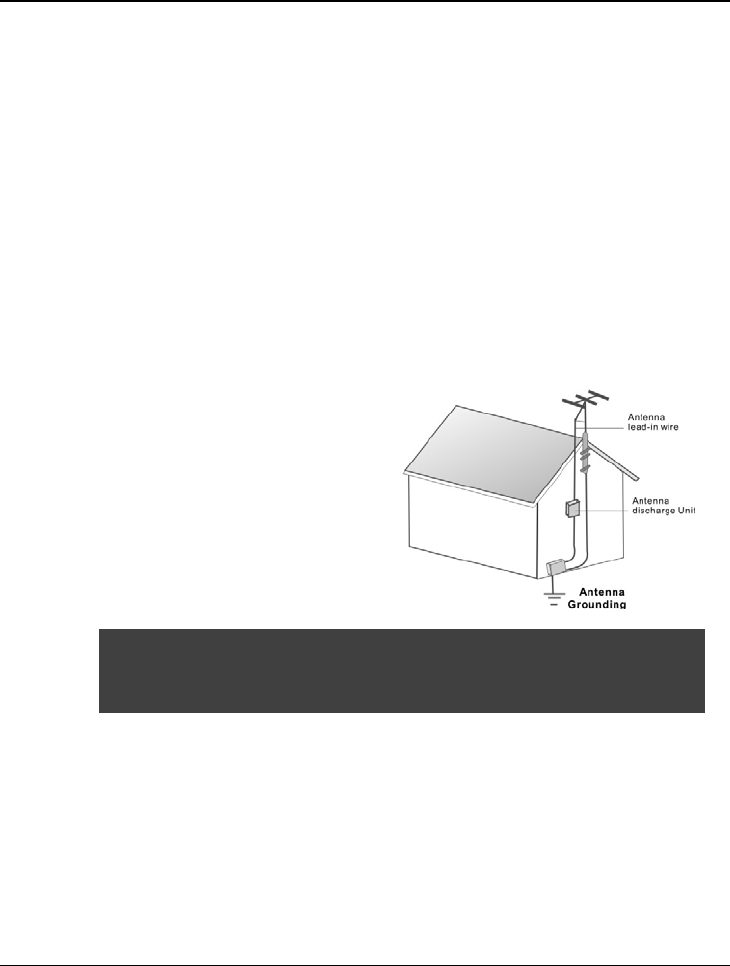
Mini EPC USER GUIDE
14
ANSI/NFPA 70, the National Electrical Code (NEC), in particular
Section 820.93, provide information with regard to proper grounding of
the mask and supporting structure, grounding of the lead-in wire to an
antenna discharge unit, size of grounding conductors, location of
antenna discharge unit, connection to grounding electrodes, and
requirements for the grounding electrode.
Lightning protection
For added protection of any product during a lightning storm or when it
is left unattended or unused for long periods of time, unplug the
product from the wall outlet and disconnect the antenna or cable
system.
Power Lines
Do not locate the antenna near
overhead light or power
circuits, or where it could fall
into such power or circuits.
WARNING: When installing or realigning an outside antenna
system, extreme care should be taken to keep from touch such
power lines or circuits. Contact with them could be fatal.
For DVD Players with both 525p and 625p
progressive scan outputs:
‘CONSUMERS SHOULD NOTE THAT NOT ALL HIGH DEFINITION
TELEVISION SETS ARE FULLY COMPATIBLE WITH THIS
PRODUCT AND MAY CAUSE ARTIFACTS TO BE DISPLAYED IN

Mini EPC USER GUIDE
15
THE PICTURE. IN CASE OF 525 OR 625 PROGRESSIVE SCAN
PICTURE PROBLEMS, IT IS RECOMMENDED THAT THE USER
SWITCH THE CONNECTION TO THE ‘STANDARD DEFINITION’
OUTPUT. IF THERE ARE QUESTIONS REGARDING OUR TV SET
COMPATIBILITY WITH THIS MODEL 525p AND 625p DVD
PLAYER, PLEASE CONTACT OUR CUSTOMER SERVICE
CENTER.’
“This product incorporates copyright protection technology that is
protected by U.S. patents and other intellectual property rights. Use
of this copyright protection technology must be authorized by
Macrovision, and is intended for home and other limited viewing uses
only unless otherwise authorized by Macrovision. Reverse
engineering or disassembly is prohibited.”
“U.S. Patent Nos. 4,631,603; 4,819,098; 4,907,093; 5,315,448; and
6,516,132.”

Mini EPC USER GUIDE
16
Contents
1 INTRODUCTION.............................................................................. 19
1.1 FEATURE HIGHLIGHT .................................................................... 19
1.2 UNPACKING THE MINI EPC........................................................... 21
1.3 THE FRONT SIDE OF THE MINI EPC............................................. 22
1.4 THE REAR SIDE OF THE MINI EPC .............................................. 23
1.5 MEMORY UPGRADE...................................................................... 26
2 GETTING STARTED....................................................................... 29
2.1 CONNECTING THE AC POWER SOURCE ...................................... 29
2.2 CONNECT YOUR MINI EPC TO A TV............................................. 30
Attach the Antenna to your mini EPC..................................... 31
Connect a TV with the S-Video connection........................... 32
2.3 CONNECT MINI EPC TO A PC MONITOR...................................... 34
2.4 INSTALLING THE MINI EPC DEVICE DRIVERS .............................. 35
driver installation note:.............................................................. 35
3 USING YOUR MINI EPC ................................................................ 37
3.1 USING MEDIA CENTER REMOTE CONTROL ................................. 37
3.2 USING WIRELESS USB KEYBOARD (OPTION).............................. 40
3.3 CONFIGURING YOUR SCREEN DISPLAY....................................... 42
3.4 HOW TO ACCESS THE OPTICAL DRIVE......................................... 42
3.5 USING FLASH MEMORY CARDS.................................................... 44
4 FUN WITH WINDOWS VISTA EXPERIENCE ....................................... 47
4.1 WHAT IS WINDOWS VISTA?.......................................................... 47
4.2 GET READY FOR WINDOWS VISTA............................................... 48
4.3 ENJOY YOUR MULTIMEDIA APPLICATION..................................... 50
Internet Explorer ........................................................................ 50
Windows Calendar .................................................................... 51

Mini EPC USER GUIDE
17
Windows Contacts..................................................................... 52
Windows Defender .................................................................... 53
Windows DVD Maker ................................................................ 54
Windows Fax and Scan ............................................................ 55
Windows Live Messenger Download...................................... 56
Windows Mail.............................................................................. 57
Windows Media Center............................................................. 58
Windows Media Player.............................................................. 59
Windows Meeting Space .......................................................... 59
Windows Movie Maker.............................................................. 60
Windows Photo Gallery............................................................. 61
Windows Update........................................................................ 62
Windows Sidebar and Gadgets............................................... 63
Gaming ........................................................................................ 64
Windows Flip and Windows Flip 3D........................................ 65
5 CONNECTING TO PERIPHERALS.............................................. 67
5.1 USING THE USB PORT ................................................................. 67
5.2 USING THE LAN PORT.................................................................. 68
5.3 USING THE IEEE 1394 PORT ...................................................... 68
5.4 USING THE AV-IN PORT (OPTIONAL)............................................ 69
5.5 USING THE WIRELESS LAN.......................................................... 71
5.6 USING THE MODEM PORT ............................................................ 71
6 BIOS SETUP..................................................................................... 73
6.1 RUNNING THE BIOS SETUP PROGRAM ....................................... 73
6.2 USING THE MAIN MENU SETUP .................................................... 74
6.3 USING THE ADVANCED CMOS SETUP......................................... 76
6.4 SECURITY MENU SETUP............................................................... 77
6.5 USING THE BOOT SETUP .............................................................. 79
6.6 HOW TO EXIT THE SETUP PROGRAM ........................................... 80

Mini EPC USER GUIDE
18
7 CARING FOR YOUR MINI EPC.................................................... 81
IMPORTANT SAFETY INSTRUCTIONS....................................................... 81
ENVIRONMENT ........................................................................................ 81
POWER SUPPLY...................................................................................... 82
CLEANING YOUR MINI EPC ................................................................... 83
MAINTAINING HARD DISK ....................................................................... 83
APPENDIX A SYSTEM SPECIFICATIONS ................................. 85
SYSTEM SPECIFICATIONS....................................................................... 86

Introduction1
19
1 Introduction
With Windows Vista, you can enjoy a growing universe of digital
media content and explore endless entertainment options from the
comfort of your couch.
With mini EPC, every member of your family can enjoy the immersive
experience of PC games and movies on a big screen. Users can
interact with an entertainment PC with an USB mouse and keyboard,
or with an optional remote control, which provides an exciting viewing
experience from the comfort of the living room sofa.
1.1 Feature Highlight
Before we go to identify each part of your mini EPC, we will first
introduce you to other notable features of your mini EPC.
Windows Vista delivers the multitasking power of a dual-core
processor and enables sleek new designs to fit your lifestyle, besides
it extends the experience you have ever had. With a full range of
powerful, yet easy-to-use digital entertainment features, you can
experience TV, DVD movies, music and photos like never before.
Processing Unit
• Your mini EPC runs on Intel ® CoreTM 2 Duo (Santa Rosa) or
Celeron ® microprocessor that is integrated with 4MB or 2MB L2
Cache. Check with your dealer on the CPU type and speed.
• Fully compatible with an entire library of PC software based on
operating systems such as Windows Vista.

Mini EPC USER GUIDE
20
Windows Vista Operating System
Windows Vista extends the experience you have. With a full range of
powerful, yet easy-to-use digital entertainment features, you can
experience TV, DVD movies, music and photos like never before.
Wireless LAN
IEEE 802.11 b/g, USB2.0 Mini Card
Memory
This mini EPC provides two memory slots for installing DDR2
SDRAM 200-pin SODIMM modules up to 4GB using 512MB,
1024MB, or 2048MB DDR2 SDRAM modules.
USB 2.0
Provides four USB ports (one at front side and three at rear side) for
fastest I/O data transmission.
Graphic System
Provides blazing graphics controller embedded in Intel® GM 965
chipset
Audio System
Azalia ALC268 sound codec chip; compliant with Intel HD Audio.
Bluetooth 2.0 (Class 2)
Bluetooth 2.0 is backward compatible with 1.x, and its EDR
(Enhanced Data Rate) is 2.1 Mbit/s. It offers a wireless connection
radius of 32.8 feet (10 meters) to other Bluetooth devices.
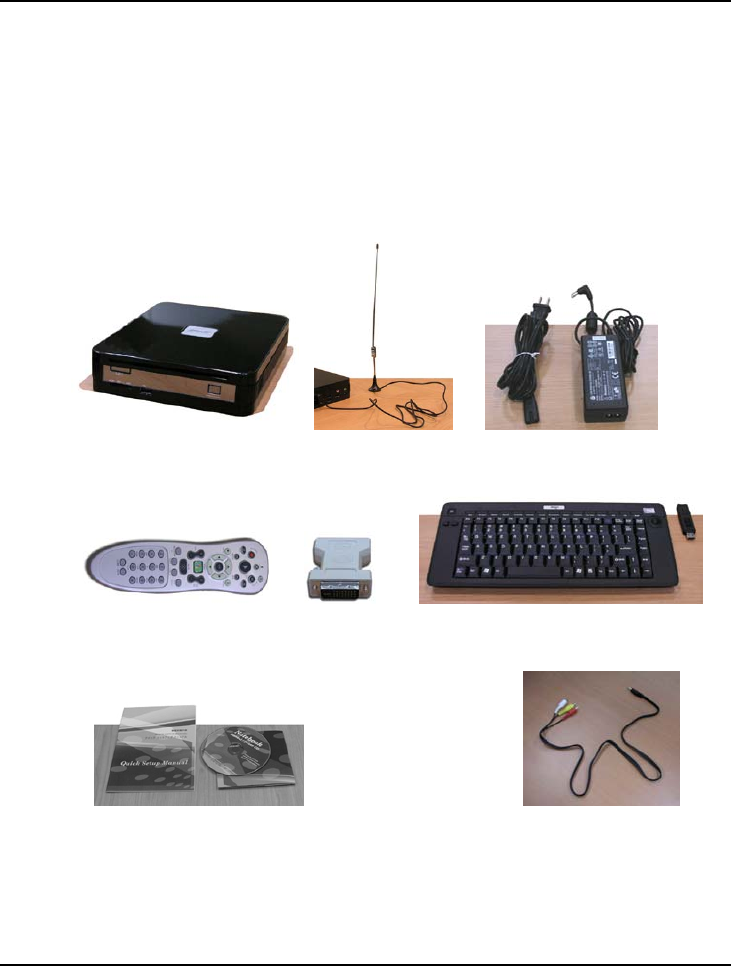
Introduction1
21
1.2 Unpacking the mini EPC
Your mini EPC comes securely packaged in a sturdy cardboard
shipping carton. Upon receiving your mini EPC, open the carton and
carefully remove the contents. The shipping carton contains the
following items:
Mini EPC Antenna AC Adapter and Power Cord
Remote Control DVI-VGA Adapter Wireless USB Keyboard
(optional) (optional) (optional)
User Manual or Manual/Drivers CD (optional) AV-IN Cable (optional)
Carefully inspect each component to make sure that nothing is
missing and/or damaged. If any of these items is missing or
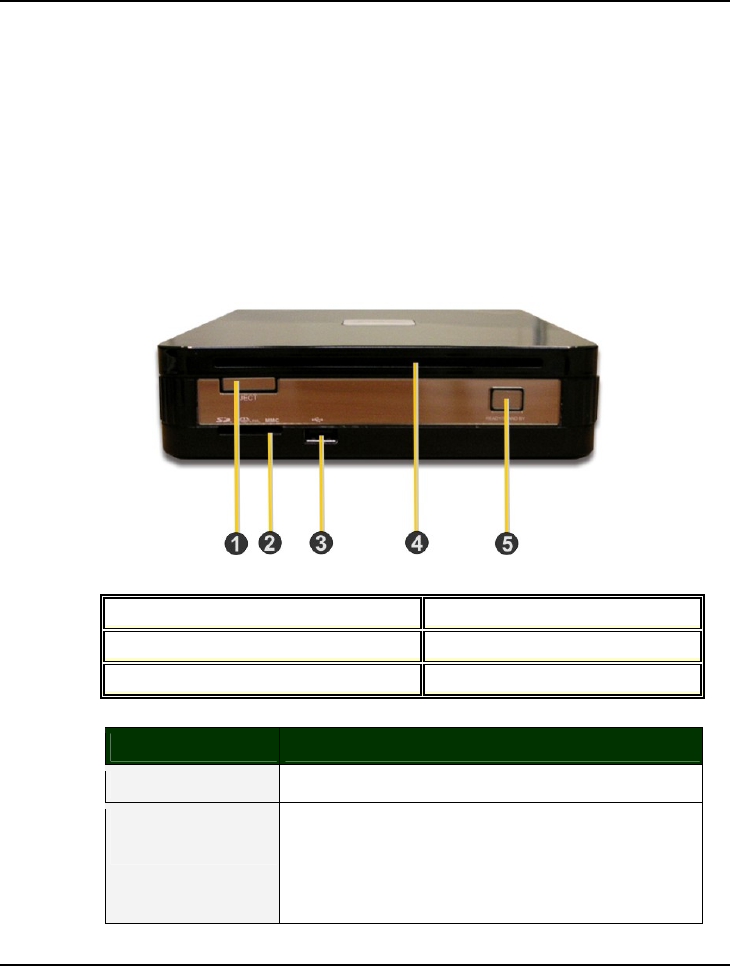
Mini EPC USER GUIDE
22
damaged, notify your dealer immediately. Be sure to save the
shipping materials and the carton in case you need to ship the mini
EPC or if you plan to store the mini EPC away sometime in the
future.
1.3 The Front Side of the mini EPC
1. Eject Button 2. 4-in-1 Card Reader
3. USB Port 4. Optical Disk Drive
5. Power On/Resume Button
Feature Description
1. Eject Button Press this button to eject optical disk.
2. 4-in-1 Card
Reader
The card slot supports SD, MMC, MS
(Memory Stick) and MS_Pro flash memory
card format. You can use any of the 4 types
flash memory cards for extra storage media.

Introduction1
23
Feature Description
3. USB Port The Universal Serial Bus (USB) port allows
you to connect up to USB-equipped peripheral
devices (for example, USB mouse, digital
camera, USB storage device and so on).
4. Optical Disk
Drive
This optical disk drive is Slot-in type ODD. It
allows you to load and start programs from a
CD/DVD and play DVD movies and audio
CDs. It also can burn CD/DVD.
5. Power On
/Resume
Button
Switches the mini EPC power on or off, or
resumes whenever it is in Suspend mode.
1.4 The Rear Side of the Mini EPC
The system ports at the back of your mini EPC can connect various
devices. Each port is described as followings.
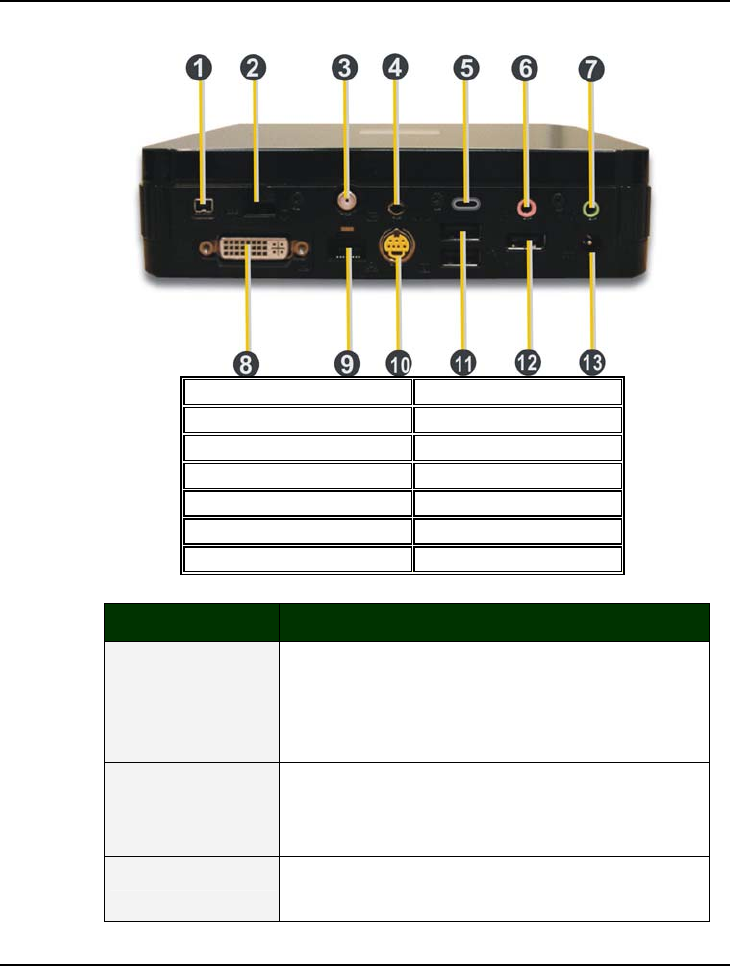
Mini EPC USER GUIDE
24
1. IEEE 1394 2. Modem Port
3. TV_IN 4. AV_In Port
5. Kensington Lock 6. Microphone Jack
7. Headphone Jack 8. DVI-I Socket
9. LAN Port 10. TV Port (S-video)
11 USB Ports 12. USB Port
13. DC_In
Feature Description
1. IEEE 1394 IEEE 1394 port is a high speed I/O port that
can transfer high levels of data in real-time,
such as Digital Video Camera, external hard
disk.
2. Modem Port A 56K internal fax/data modem is built-in. It
keeps you connected to the outside networks
through telephone line.
3. TV_IN Connects to an antenna to receive television
signal for watching and recording TV programs.

Introduction1
25
Feature Description
4. AV_In Port This port is for Audio and Video input.
5. Kengsington
Lock
Lets you attach a Kensington security system
or a compatible lock to physically secure your
mini EPC.
6. Microphone
Jack
Allows you to connect an external microphone.
7 Headphone
Jack
Lets you plug in high-definition headphone,
powered speakers, or earphone. (The SPDIF
transmits digitized audio signal by optical fiber.
The external audio amplifier can get the best
audio quality without loss.)
8. DVI-I Socket This socket can accept both analog signal
(VGA) and digital signal (DVI) inputs.
The “DVI-I” is the abbreviation of “Digital Video
Interactive-Integrated”.
9. LAN Port An internal 10/100/1000Base-T Gigabit
Ethernet LAN module connects your mini EPC
to other mini EPCs/networks through a local
area network (LAN).
10. TV Port (S-
video)
Lets you connect to the S-Video TV connector
for watching TV programs or DVD movie.
11. 12. USB Ports The Universal Serial Bus (USB) port allows you
to connect up to USB-equipped peripheral
devices (for example, USB mouse, digital
camera, USB storage device and so on).
13. DC_In Lets you connect the AC power adapter in
supplying continuous power to your mini EPC.
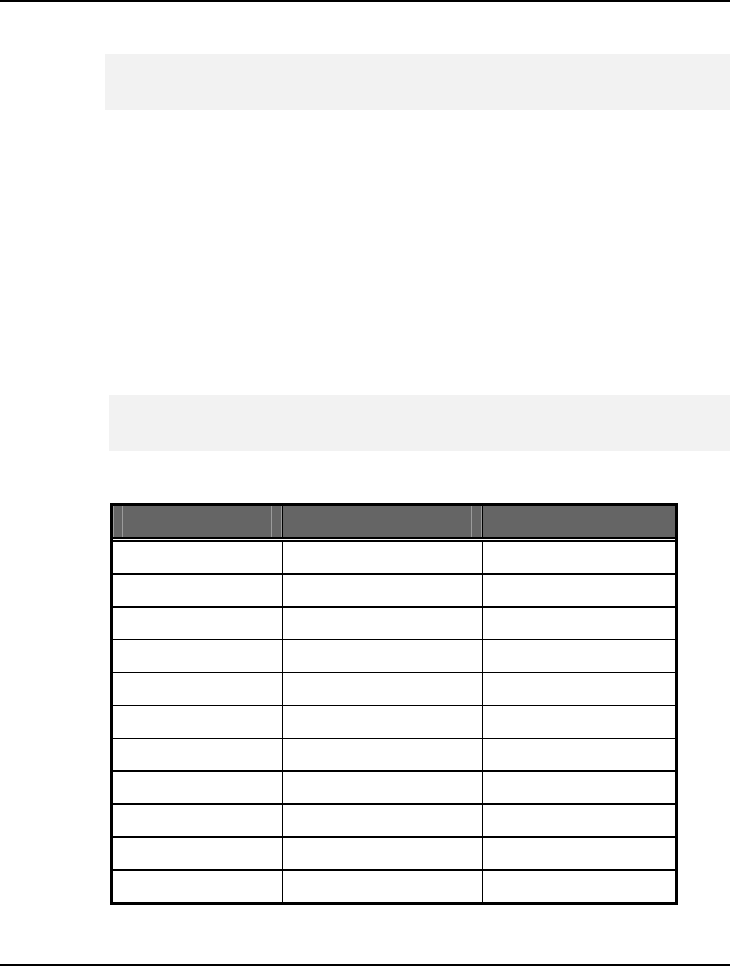
Mini EPC USER GUIDE
26
The audio function is available after inserting the speaker or
headphone into audio port..
1.5 Memory Upgrade
Your mini EPC offers 200-pin SODIMM (Small Outline Dual Inline
Memory Module) at least 256MB DDR2-SDRAM. The memory
compartment is located inside your mini EPC. The table below lists
the possible combinations of different memory module and memory
size.
Please contact dealer for changing or adding DDR2-SDRAM
module. It is not available for users to change it by themselves.
Based Memory Installing Memory Total
512 MB 0 MB 512 MB
512 MB 512 MB 1024 MB
512 MB 1024 MB 1536 MB
512 MB 2048 MB 2560 MB
1024 MB 0 MB 1024 MB
1024 MB 512 MB 1536 MB
1024 MB 1024 MB 2048 MB
1024 MB 2048 MB 3072 MB
2048 MB 0 MB 2048 MB
2048 MB 512 MB 2560 MB
2048 MB 1024 MB 3072 MB

Introduction1
27
Based Memory Installing Memory Total
2048 MB 2048 MB 4096 MB

Getting Started 2
29
2 Getting Started
Your mini EPC is designed and pre-configured for easy setup and
use. This chapter describes the installation steps you should follow to
get the mini EPC up and running as quickly as possible. Contact your
dealer if they have pre-installed all the needed drivers to fully operate
your mini EPC or if there is the updation on the driver installation of
the mini EPC.
2.1 Connecting the AC Power Source
The AC adapter provides external power source to your mini EPC
and the AC adapter also has an auto-switching design that can
connect to any 100VAC ~ 240VAC power outlets.
To connect the power adapter:
1. Plug the AC power cord into the power socket of the AC power
adapter. And plug the other end of the AC power cord to a live
AC wall outlet.
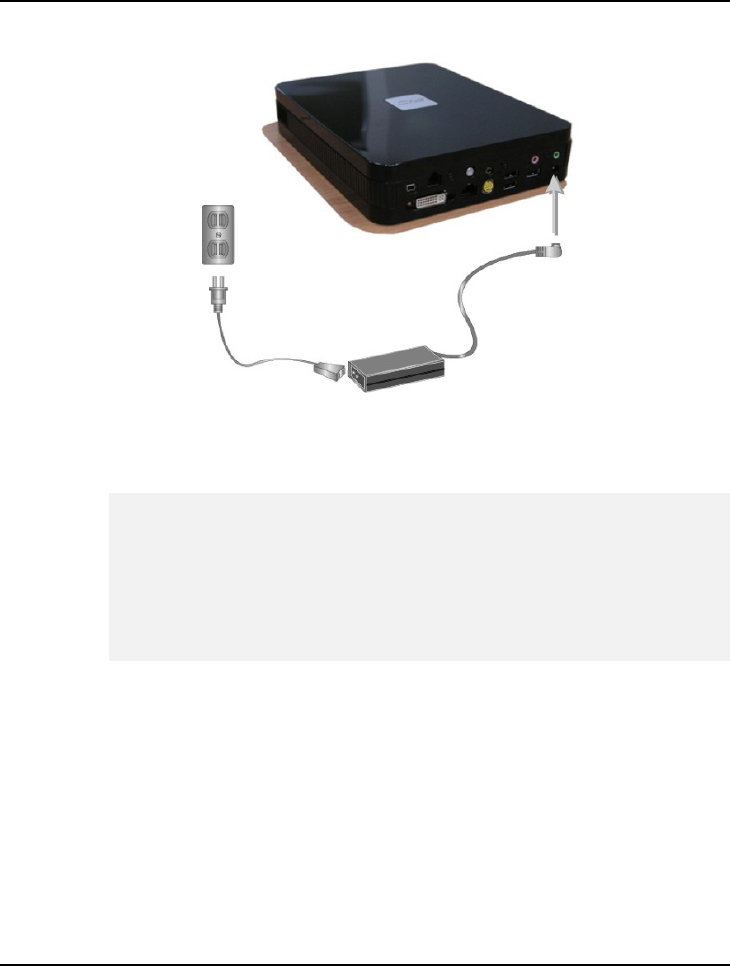
Mini EPC USER GUIDE
30
2. Plug the connector of the AC adapter to the DC-IN port found at
the rear side of the mini EPC.
y
For the power supply of this equipment, an approved power
cord has to be used.
y
Make sure the socket and any extension cord(s) you use can
support the total current load of all the connected devices.
y
Before cleaning the mini EPC, make sure it is disconnected from
any external power supplies (i.e. AC adapter).
2.2 Connect your mini EPC to a TV
Connect your mini EPC (running Microsoft Windows Vista) to your
TV, and you can enjoy your favorite mini EPC and TV entertainment
from the same spot in your living room. You can enjoy live and
recorded TV, DVDs, music, photos, and Online Spotlight's offerings

Getting Started 2
31
on the big screen from the comfort of your couch — and you can
control it all with a single remote control.
Attach the Antenna to your mini EPC
This Mini EPC has built-in a TV tuner card to process analog
television signals. (Beside, this TV tuners card functions as video
capture cards to record television programs onto a hard disk.)
TV tuners supporting digital television broadcasts have recently
become available; a tuner displaying an HDTV image on a mini EPC
monitor is typically much cheaper than a dedicated high-definition
television system. The TV tuner card also supports time-shifting
capabilities, allowing the viewer to rewind, fast-forward and pauses
live TV.
The Mini EPC also comes with an Antenna. To receive television
signal well, you need to attach the antenna to your mini EPC.
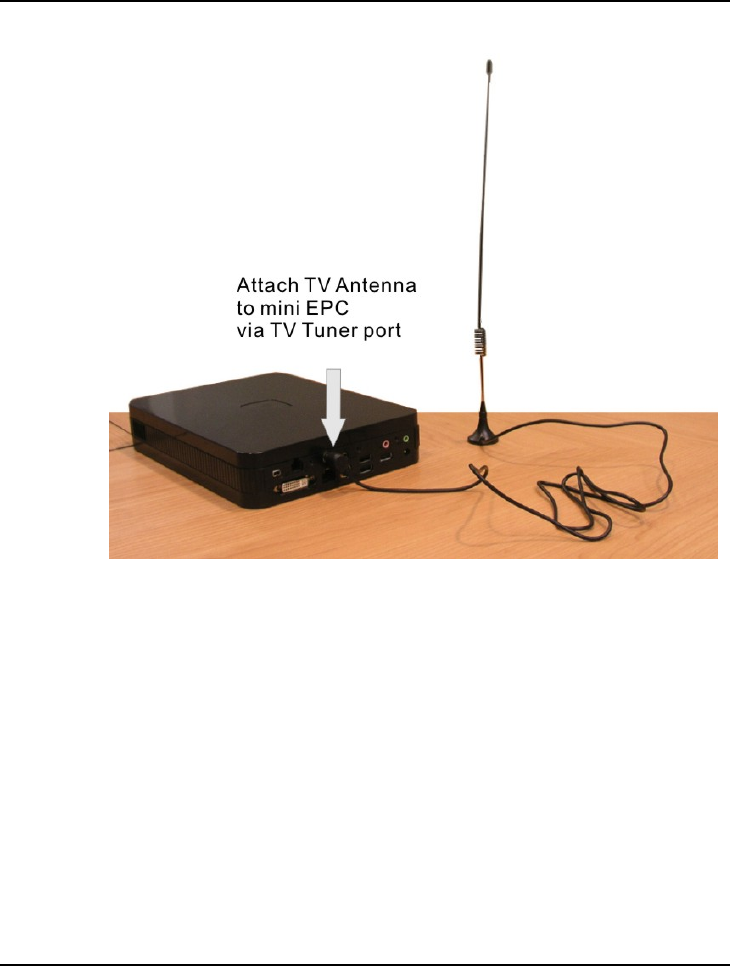
Mini EPC USER GUIDE
32
Connect a TV with the S-Video connection
1. Connect the S-Video cable to your TV Port, located on the back
of your Media Center PC.
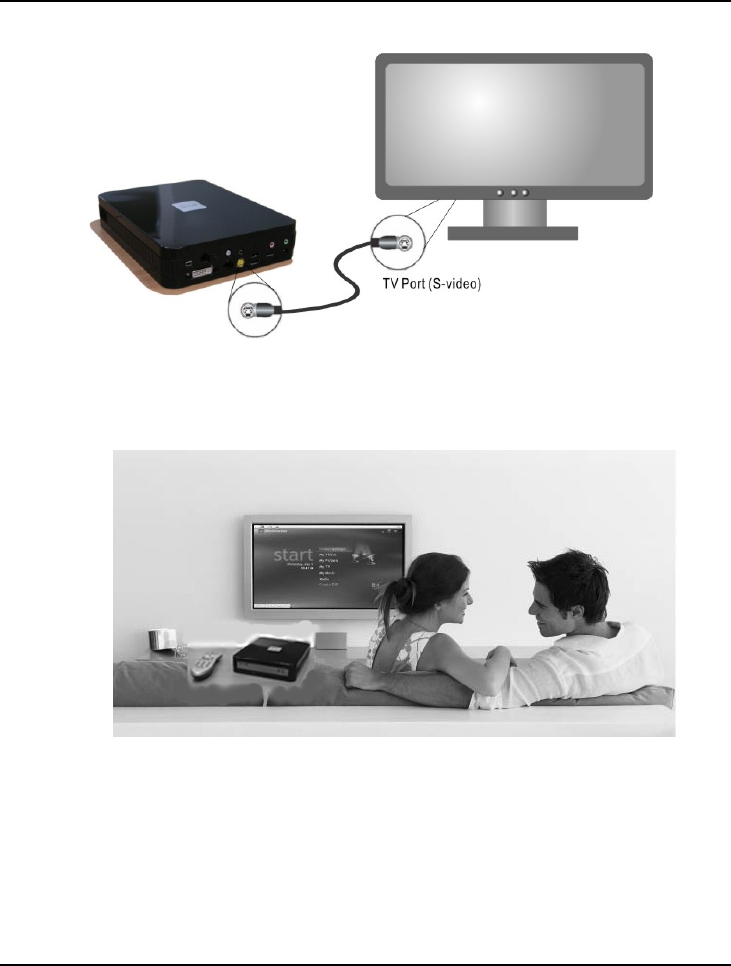
Getting Started 2
33
2. Connect the other end of the S-Video cable to the S-Video input
connection on the back of your TV.
Enjoy your digital Lifestyle
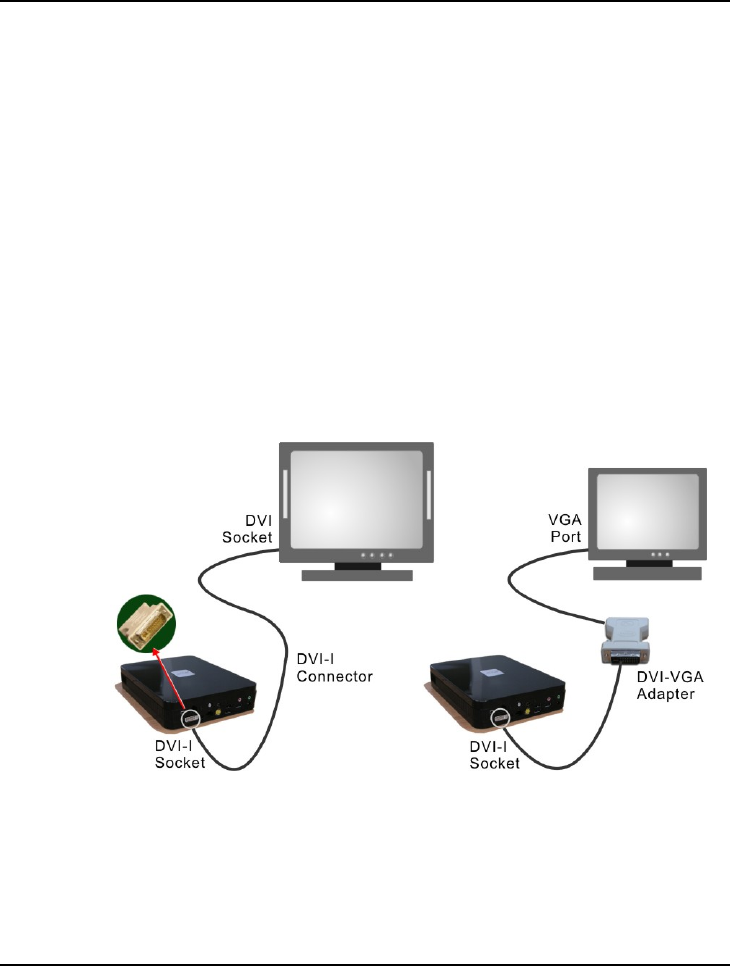
Mini EPC USER GUIDE
34
2.3 Connect mini EPC to a PC Monitor
You can connect a monitor to your PC mini EPC with running
Microsoft Windows Vista. All you have to do is plug the cable from
the monitor into the back of the high-level mini EPC with a DVI-I
Socket.
Most monitors use a VGA cable to connect to a PC. In this case, you
can connect the VGA cable from the monitor to the DVI-I Socket on
the back of your Media Center PC via a DVI-VGA Adapter. Or you
can connect directly to the monitor with DVI socket.
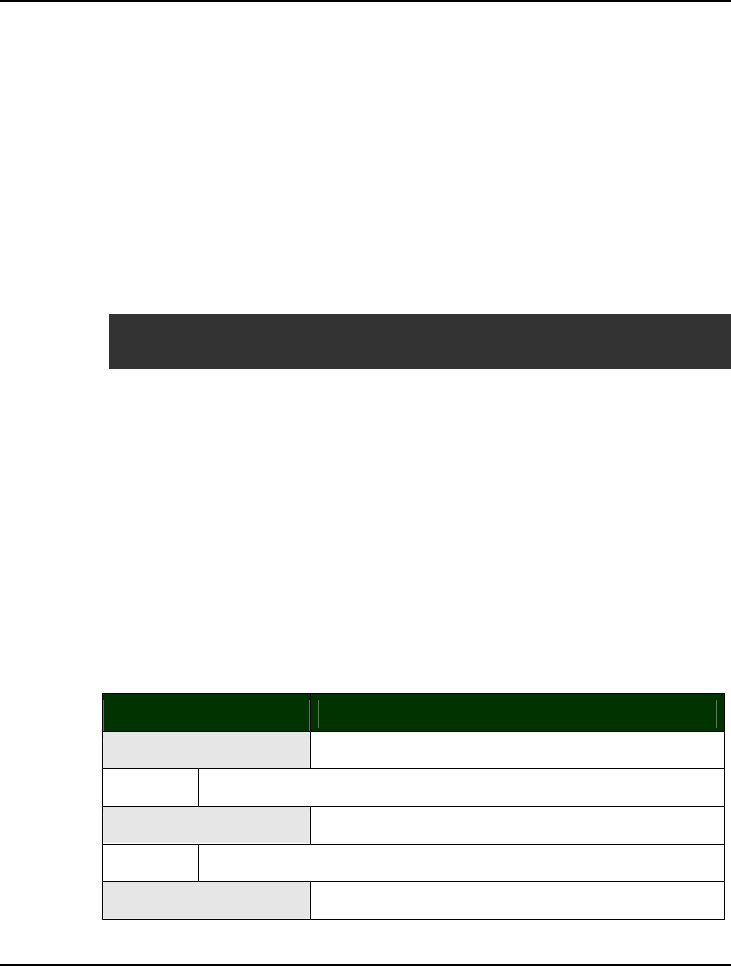
Getting Started 2
35
2.4 Installing the Mini EPC Device Drivers
It is best to install the needed device drivers for using the built-in
devices of your mini EPC. Before installing the drivers, check with
your dealer first if they have already installed all the drivers along
with the operating system. If not, follow the procedures below:
DRIVER INSTALLATION NOTE:
NOTE: Please be notified that whenever you install the driver
utility, it should be install the CHIPSET Driver first.
Installing Drivers for Windows Vista x86
1. From the Windows toolbar, click the Start button, then point to
Run. The Run dialog box appears.
2. Click the Browse button and specify the directory as where the
device driver is located.
3. Read the on-screen information, and follow the on-screen
instructions to complete drivers installation.
Device Driver Driver Path
Chipset device
"E:\Drivers\Vista32\Chipset\Setup.exe"
VGA device
"E:\Drivers\Vista32\VGA\Setup.exe"
Audio device
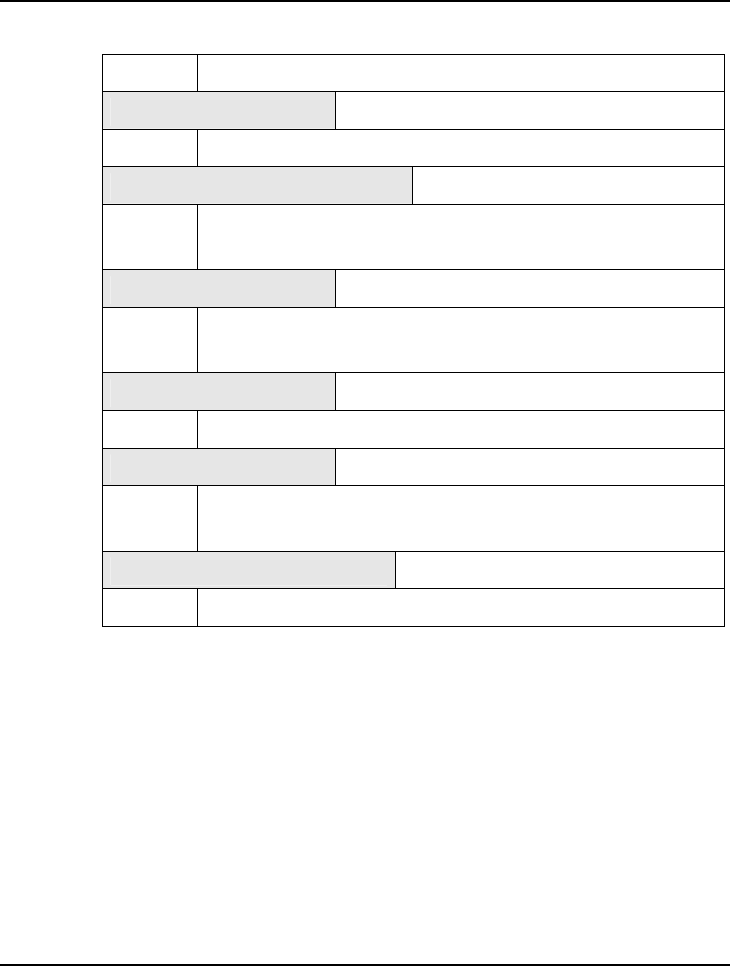
Mini EPC USER GUIDE
36
"E:\Drivers\Vista32\Audio\Setup.exe"
Modem driver
"E:\Drivers\Vista32\Modem\Setup.exe"
Wireless LAN driver and Utility
“E:\Drivers\Vista32\Wireless LAN\Azurewave
GU701\Setup.exe”
LAN driver
"E:\Drivers\Vista32\LAN\SetupYukonWinC_5X6N.exe
"
CIR driver
"E:\Drivers\Vista32\CIR\DPInst.exe"
TV Tuner driver
"E:\Drivers\Vista32\TV Tuner\A316_Vistalogo_
DRV_x86_V1.3.0.30.exe"
Bluetooth Driver and Utility
"E:\Drivers\Vista32\Bluetooth\setup.exe"

Using Your Mini EPC 3
37
3 Using Your Mini EPC
This chapter describes how to operate the standard features of the
mini EPC. With mini EPC, every member of your family can enjoy the
immersive experience of PC games and movies on a big screen.
Users can interact with an entertainment PC with an USB mouse and
keyboard, or with an optional remote control, which provides an
exciting viewing experience from the comfort of the living room sofa.
3.1 Using Media Center Remote Control
The mini EPC comes with a Media Center remote control, and this
Media Center remote control bring your Media Center experience to a
whole new level.
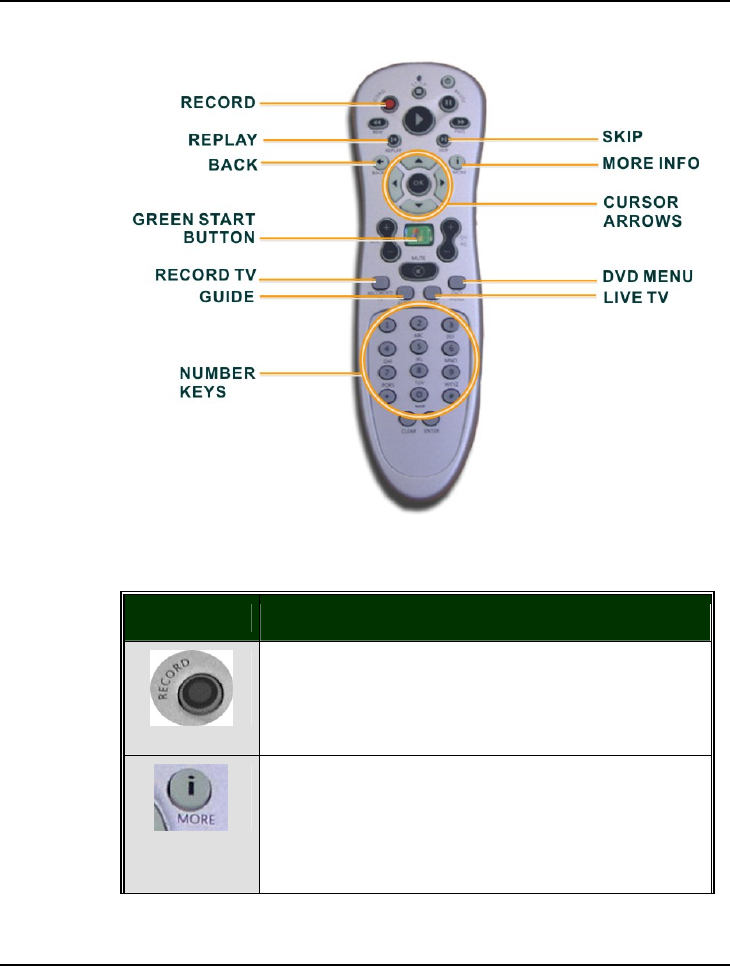
Mini EPC USER GUIDE
38
Media Center Remote Control
Button Description
Press the RECORD button on the remote to
begin recording what you’re currently watching.
To find and watch it later, simply press the
RECORD TV button.
The MORE INFO button brings up additional
option related to where you are in the menu
system. You can also press MORE INFO to get
details on the music, TV, pictures, or video that
is selected.
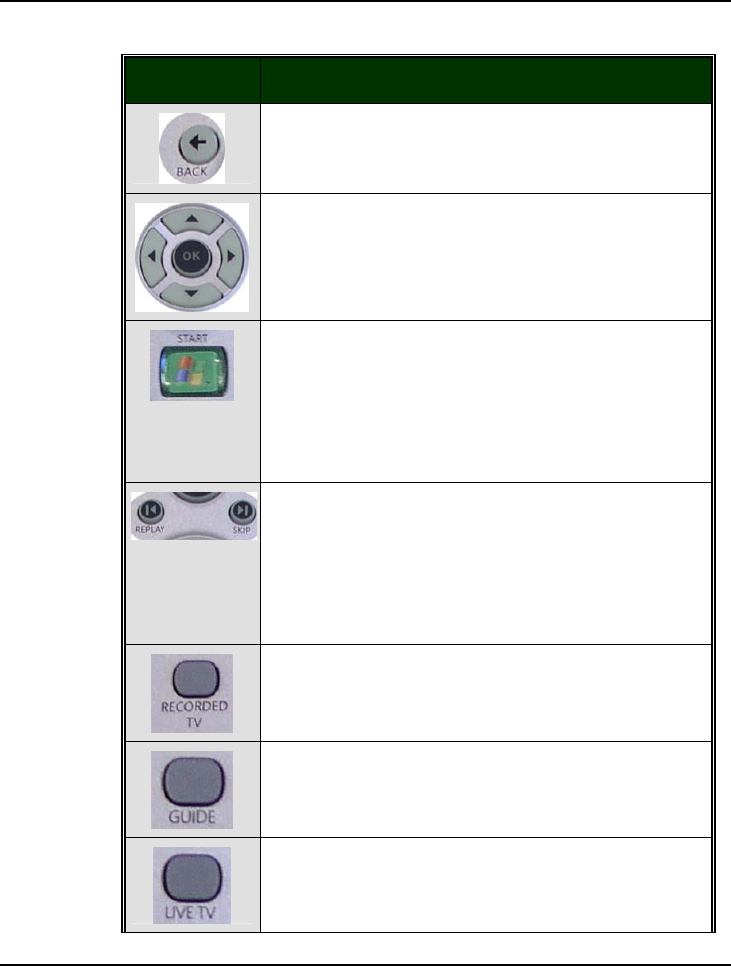
Using Your Mini EPC 3
39
Button Description
When navigating through the Media Center
menu system, press the BACK button to go to
the previous screen.
Use the CURSOR ARROWS to navigate up,
down, left, or right through the Media menu
system. When you find what you want, press OK
button in the center of the arrows to select it.
The GREEN START BUTTON will launch the
Media Center menu system when you are in
Windows Vista. If you are navigating around the
Media Center, press GREEN START BUTTON
will bring you back to the Media Center Starting
menu options.
Press SKIP on the remote to jump forward in 30
seconds time increments in the recorded TV
show you’re watching. If you want to see that
great sports play again when watching live TV or
recorded TV, press REPLAY on the remote and
watch it again.
Press RECORD TV to go directly to the
Recorded TV menu and see what recorded TV
programs you have saved on the mini EPC.
Press the GUIDE button to go directly to the TV
program listings and find a show to watch now or
to select a show or series to record in the future.
Press the LIVE TV button to bring up TV on the
screen of the television connected to your mini
EPC.
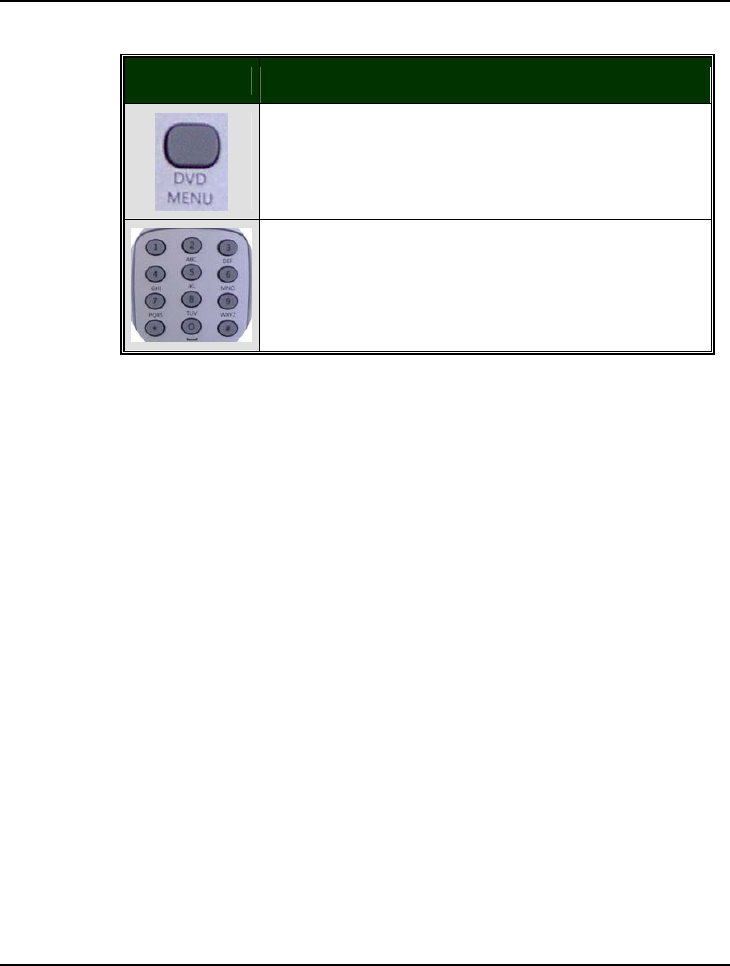
Mini EPC USER GUIDE
40
Button Description
Press the DVD MENU button to access the main
menu of the DVD in your DVD drive and to begin
watching it.
Use the NUMBER KEYS to go directly to the TV
channel you want to watch or use them to type
letters, numbers, or symbols into a search box.
3.2 Using Wireless USB Keyboard
(option)
Before using the wireless USB keyboard, you must activate
communication between the mini EPC and the wireless USB
Keyboard.
Please follow the steps to install the wireless USB keyboard.
1. Turn the keyboard upside down to open the battery compartment
which is located on the bottom of the keyboard.
2. Insert supplied batteries and replace battery compartment cover.
3. Connect USB Receiver to the USB port at the min EPC.
4. Press the button on the USB Receiver, then press “ID Link”
button on the keyboard within 10 seconds to communicate
signals.
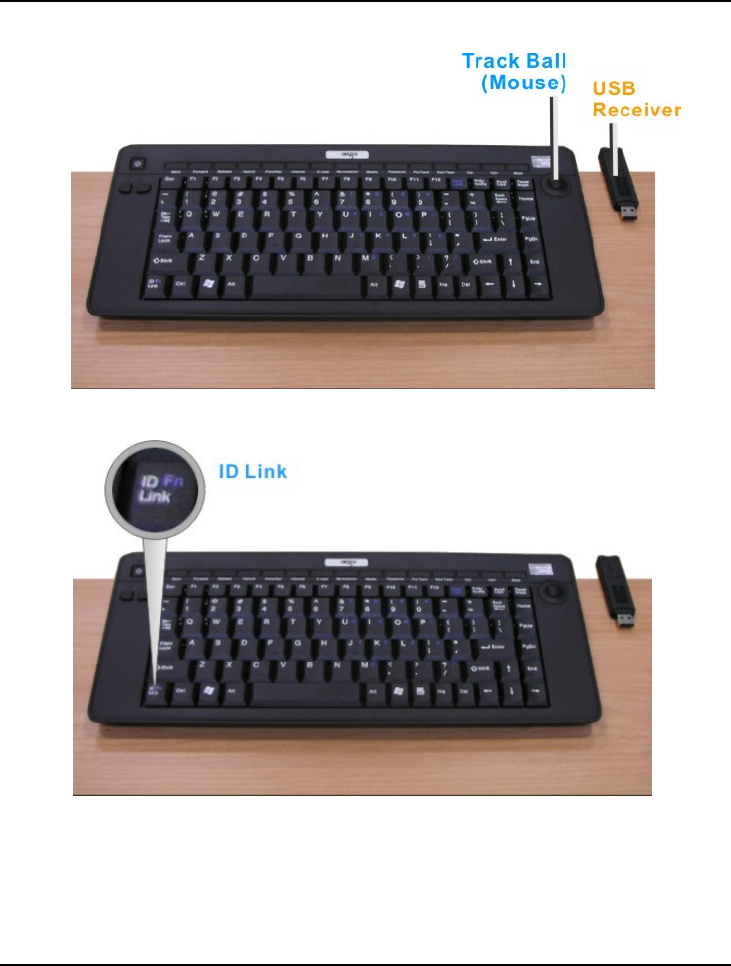
Using Your Mini EPC 3
41
Key numbers: 99Keys (including hot-keys)
with Track Ball (mouse) function
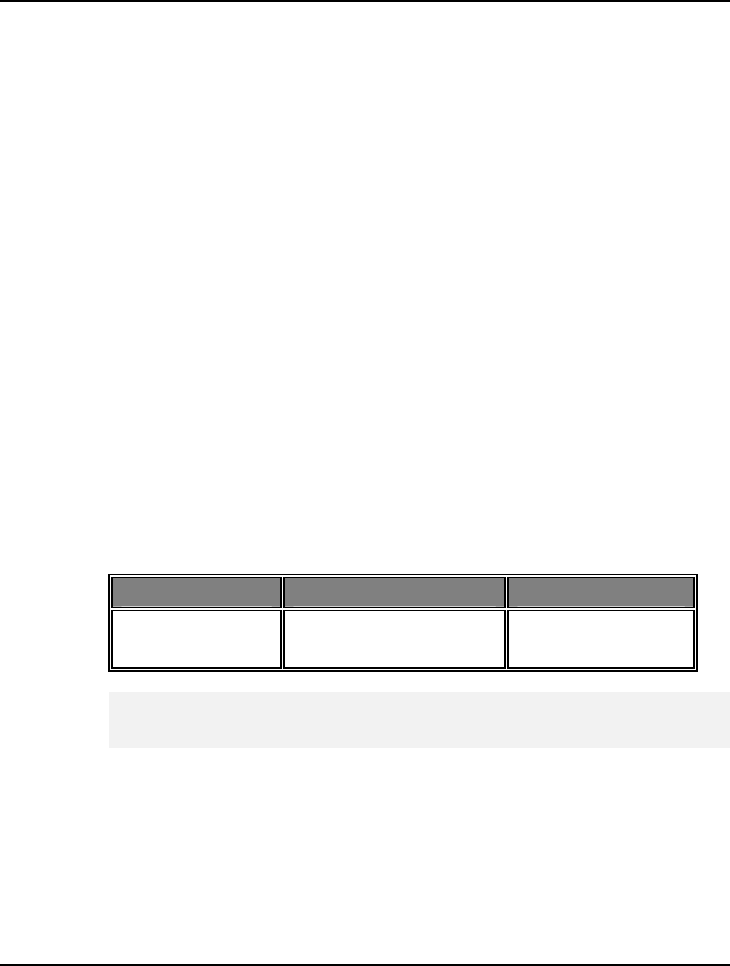
Mini EPC USER GUIDE
42
Battery: AA size Battery x4
Parameters for Remote Control
Distance for remote control: within 5m.
Angle for remote control: 360 degrees
Frequency for signal transmitted: at 2.4GHz frequency.
Standby Mode: System will wait for 5 minutes to activate Standby
Mode if there is no any input signal. You can touch any key to
resume system. During Standby Mode, mouse (pointing device) will
be disabled while keyboard function reminds alive.
3.3 Configuring Your Screen Display
Possible Display Configurations
The table below shows you the possible display resolution you can
set when using either the LCD display or the external monitor (CRT):
Display Maximum Resolution Maximum Colors
External Monitor 1600x1200, 85Hz
32-bit true colors
65,536 or 64K colors is also equivalent to 16-bit high color while 16
million or 16M colors is equivalent to 32-bit true color.
3.4 How to Access the Optical Drive
Your mini EPC is equipped with a Slot-in type DVD multi/Combo
drive on the front panel of the mini system. You can play music from
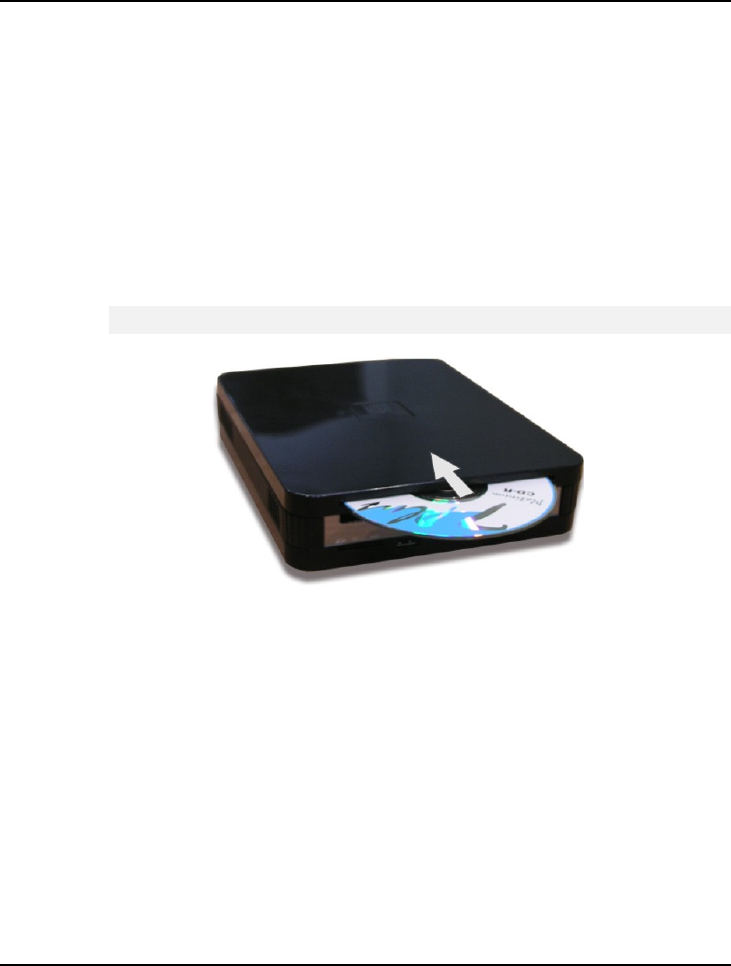
Using Your Mini EPC 3
43
audio CDs or play DVD movies. You can also burn music CDs, and
save documents and other digital files on CD-R/DVD-R or CD-
RW/DVD-RW discs.
To insert and remove an optical disk on the drive:
1. Make sure the mini EPC is turned on.
2. Slide the optical disk into the slot-in type optical drive with the
label side facing up.
Some DVD are two-sided and don’t have a label on the either side.
3. To remove the optical disc. Be sure close CD/DVD player related
programs.
4. Press the eject button under the optical drive slot. Then the
optical disc will slide out.
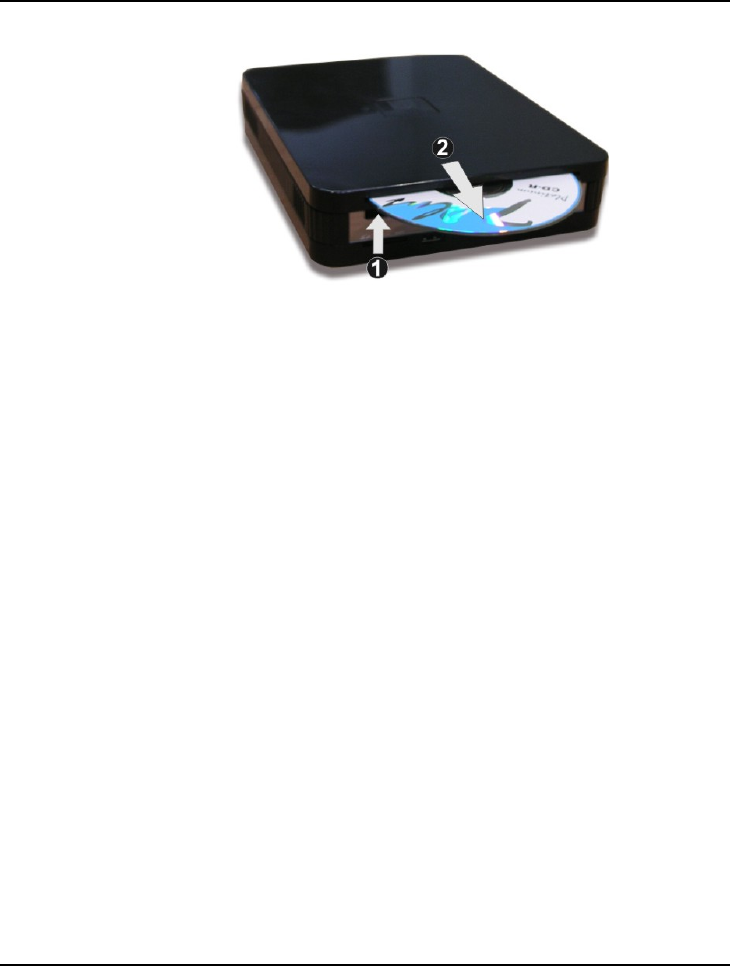
Mini EPC USER GUIDE
44
How to care the CD/DVD
When you handle CDs, pay attention to the following guidelines:
• Always pick up the CD by its edges.
• Avoid scratching or soiling either side of the CD.
• Do not write with the hard ball-point pen or apply labels on either
side of the CD.
• Keep the CD away from direct sunlight or high temperatures.
• Clean fingerprints or dust from the CD by wiping it with a soft
cloth.
3.5 Using Flash Memory Cards
What is Flash Memory Card?
Flash Memory is a memory storage media. They are used by most
digital camera, mobile phone, and PDA. Flash memory cards are
built with different form factor and brand name. Their sizes are
smaller than PCMCIA card. The 4 in 1 card slot of this mini EPC
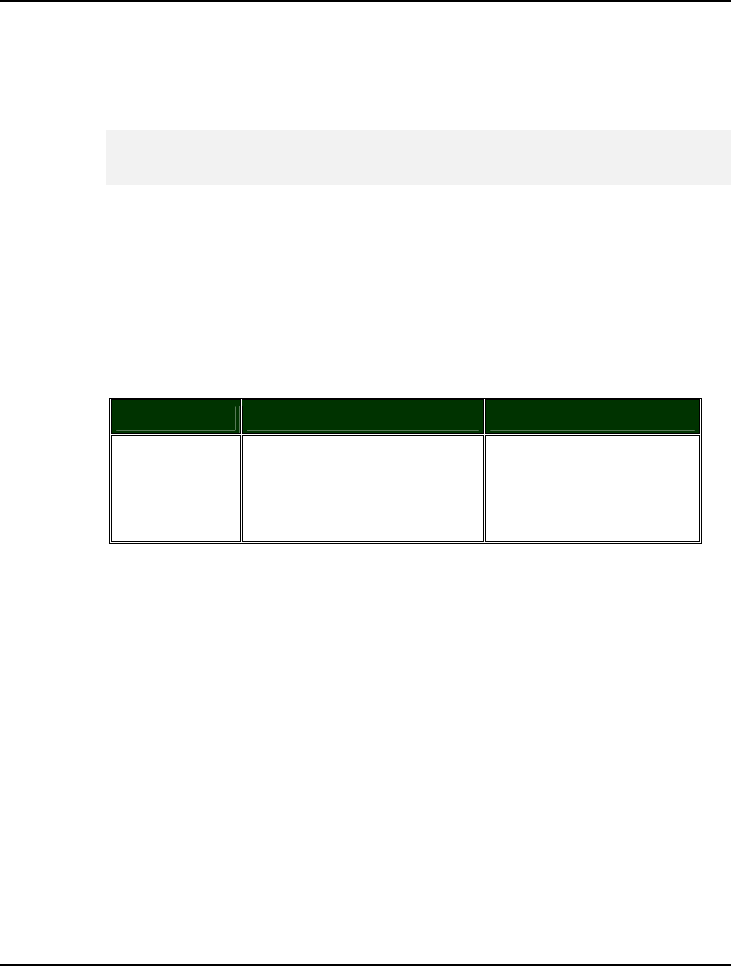
Using Your Mini EPC 3
45
supports the flash memory card as SD, MMC, MS (Memory Stick),
and MS_Pro cards.
For a single moment, only one card can be inserted into the 4 in 1
card slot.
To insert and remove a Flash Memory Card:
For MMC and SD card, you should position the copper connector at
the bottom side. For Memory Stick card, you should position the
copper connector at the topside. All of these cards should be located
at the center of the slot in inserting.
Slot Card type Copper connector
4 in 1 SD (Secure Digital)
MMC (MultiMedia Card)
MS (Memory Stick)
MS_Pro
Bottom side
Bottom side
Top side
Top side
Only one correct side can be accepted for the 4 in 1 card slot. If you
cannot insert the card into the 4 in 1 slot or you had inserted the card
but it is not recognized by the mini EPC, please remove the card and
turn the card upside down and insert it again. To prevent the damage
made both on card and the slot, never force an entry into the slot with
incorrect side.
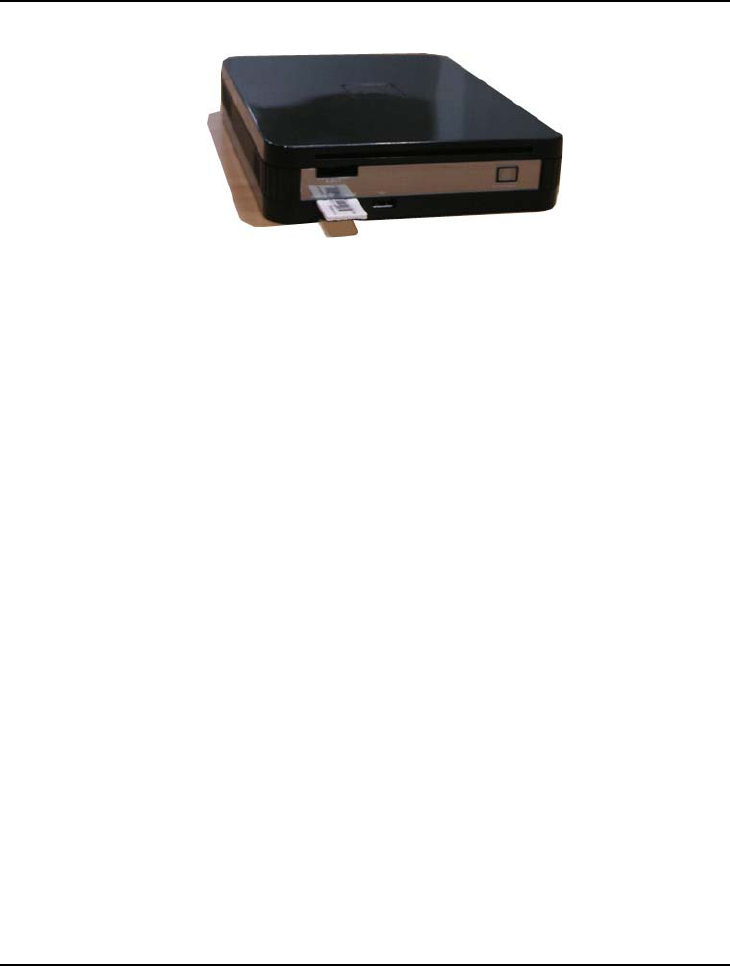
Mini EPC USER GUIDE
46
To remove the flash memory card, you should first disable the card
setting at the taskbar of the windows Vista. Then, you only pull out
the card by fingers; there is no release button for flash memory slot.

Fun with Windows Vista Experience 4
47
4 Fun with Windows Vista
Experience
The Mini EPC (Mini Entertainment PC) integrated in a highly compact
platform is designed for digital entertainment. With Windows Vista, it
offers a breakthrough user experience and is designed to help you
feel confident in your ability to view, find, and organize information
and to control your computing experience. It simplifies our digital life
in taking charge of media, share moves, TV, photos, and music with
your friends and family.
4.1 What is Windows Vista?
Windows Vista is an operating system that enables you to enjoy the
best in entertainment on your notebook.
The visual sophistication of Windows Vista helps streamline your
computing experience by refining common window elements so you
can better focus on the content on the screen rather than on how to
access it.
With Windows Vista, you can store, share and enjoy all of your
photos, all of your music, all of your home video and even recorded
TV. It’s all contained in one control system. That is as easy to use
with a great new user-friendly interface.
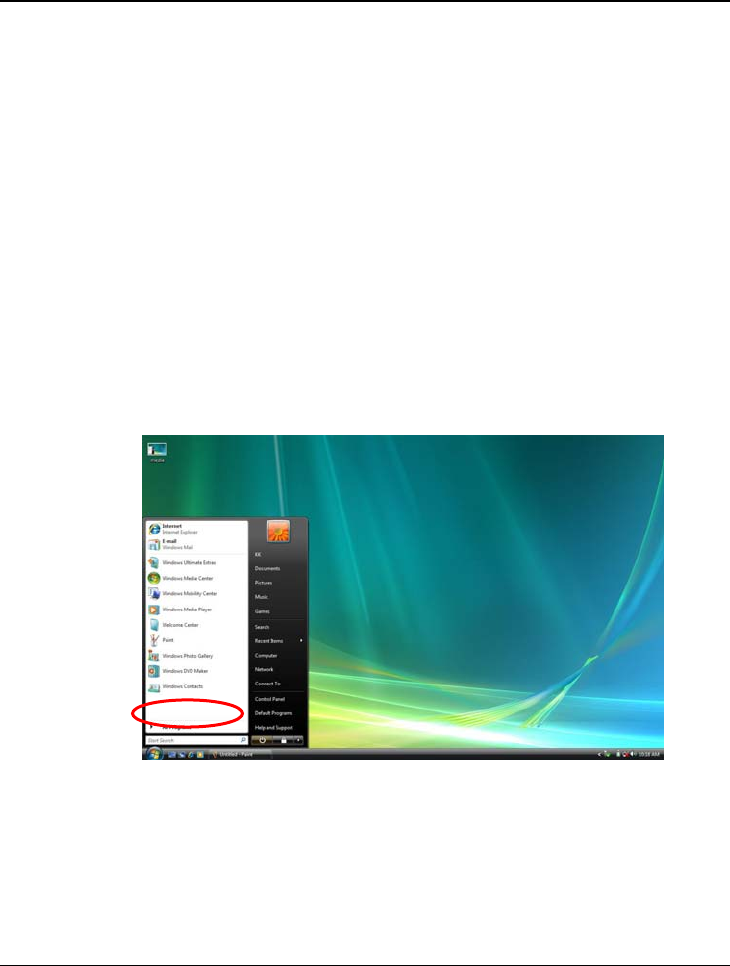
Mini EPC USER GUIDE
48
4.2 Get Ready for Windows Vista
Windows Vista is designed to help make you more productive as you
work with your PC throughout the day with new features.
Starting the Windows Vista
When you start using Windows Vista, you will recognize familiar
elements such as the Start menu, which is now faster, more
streamlined, and more helpful than in previous versions of Windows.
More than that, the new start menu makes it very easy for you to
navigate across all of the installed applications on your PC.
Eliminating the slow performing, cascading "All Programs" view, the
new start menu can help you get something started more quickly
than ever.
About the entertainment
To recall all default multimedia applications, click on “All Programs”
located on the left corner on the desktop, the “All Programs” will be
changed to “Back” as shown in the following figure.
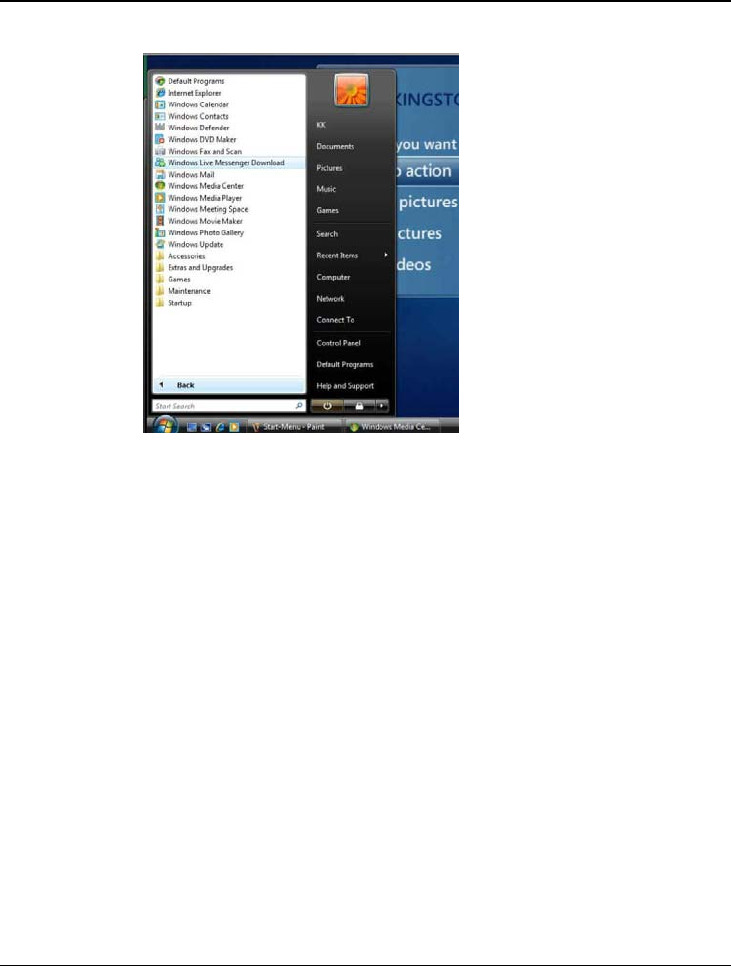
Fun with Windows Vista Experience 4
49
It now becomes more easy to execute various application with just
click on it.
Instant Search
The Start menu features integrated desktop search through a new
feature called Instant Search which can help you find and launch
almost anything on your PC. Just type in a word, a name, or a
phrase, and Instant Search can find the right file for you.
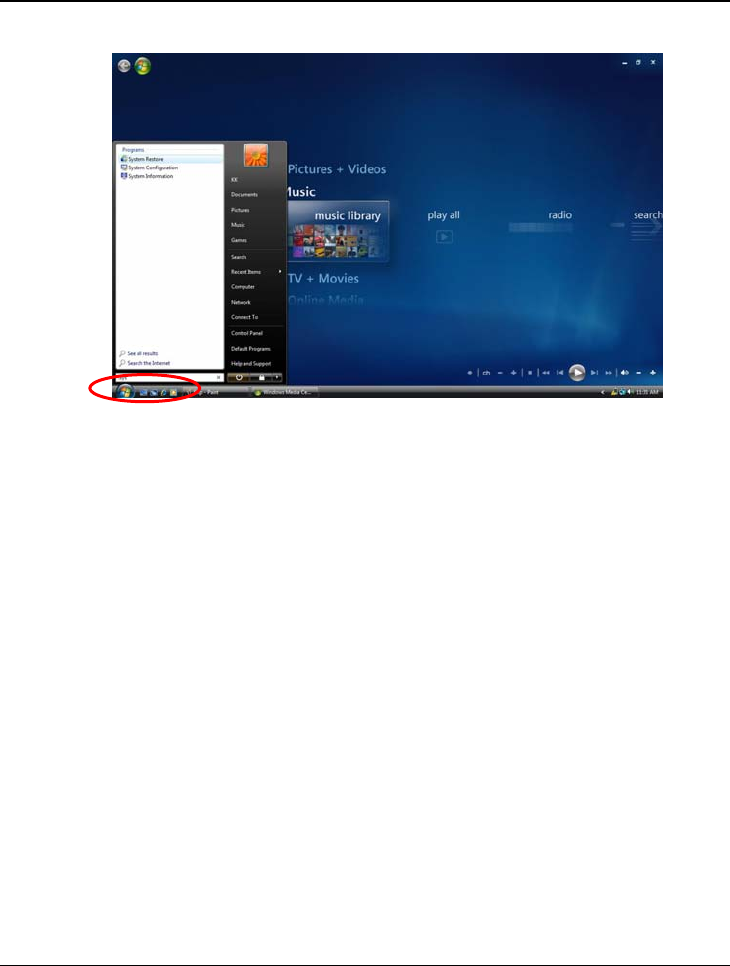
Mini EPC USER GUIDE
50
Use Instant Search to quickly find the information you need.
4.3 Enjoy Your Multimedia Application
Internet Explorer
Windows Vista enhances the Internet Explorer experience in finding
and displaying information, and Web sites on the Internet.
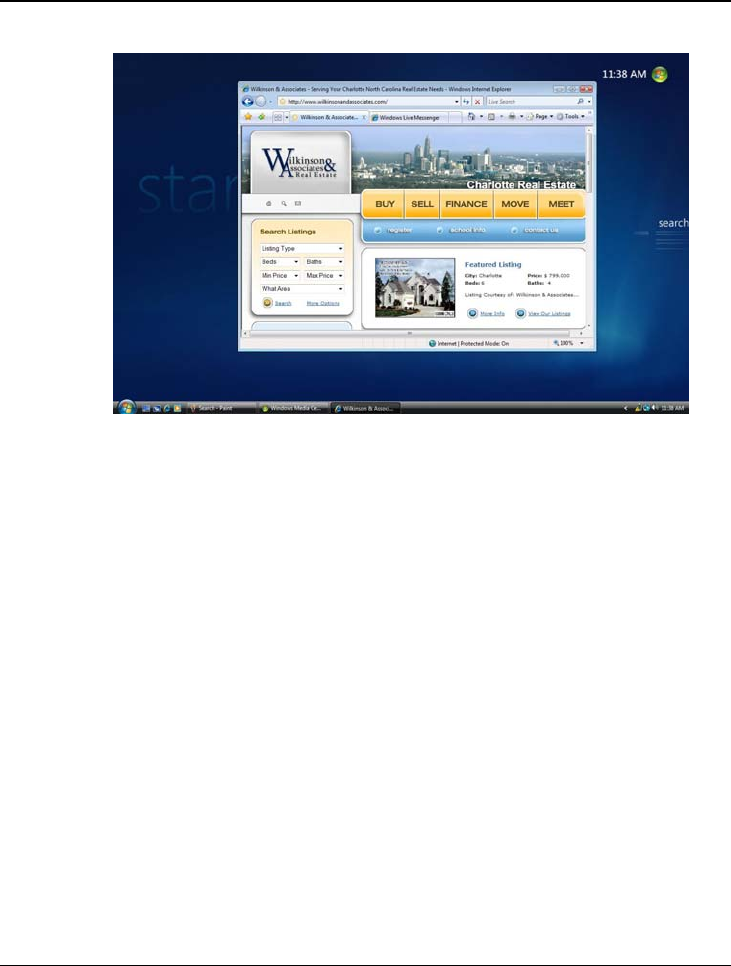
Fun with Windows Vista Experience 4
51
The upcoming release of Internet Explorer 7 not only adds important
new security and privacy features, but makes everyday tasks easier
through features such as tabbed browsing, inline search, and shrink-
to-fit printing
Windows Calendar
Windows Calendar helps you in management appointments and
tasks by creating personal calendar, publishing them, and subscribe
to other users calendars.
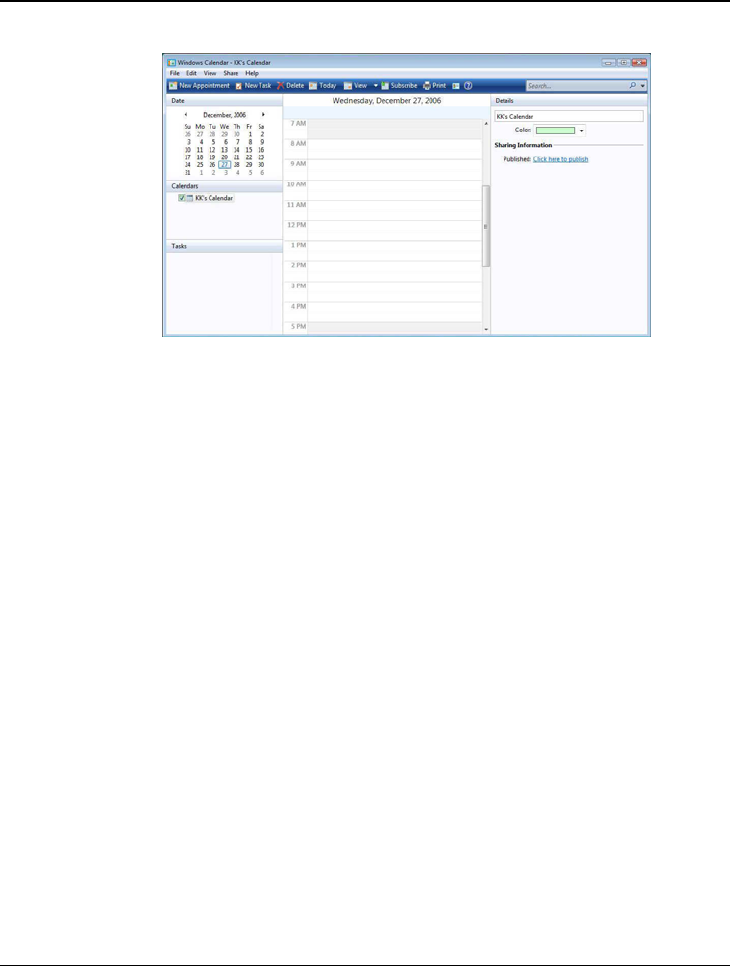
Mini EPC USER GUIDE
52
Windows Calendar is a flexible, easy-to-use calendar built directly into the
Windows Vista operating system. It lets you plan and manage all of
your activities and coordinate your schedule with others. It also lets
you create a personal task list and receive automatic notifications
and reminders about specific tasks and upcoming appointments.
Windows Calendar has a broad range of features to help you
manage your personal schedule
Windows Contacts
Windows Contacts can store e-mail addresses and other information
about people and organizations.
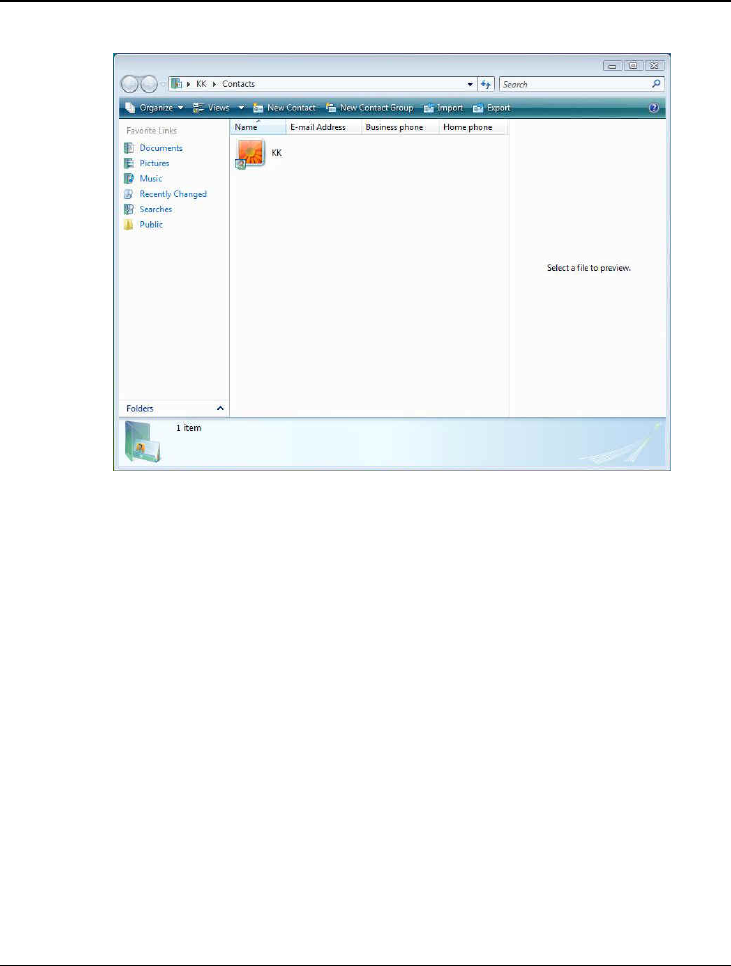
Fun with Windows Vista Experience 4
53
Microsoft Windows Vista provides a new mechanism and user
interface for storing and retrieving information about people (contacts)
who are important to the users of Microsoft Outlook and Windows
Mail (formerly Outlook Express).
Windows Defender
Windows Defender is enable to protect the computer from spyware
and other potentially unwanted software.
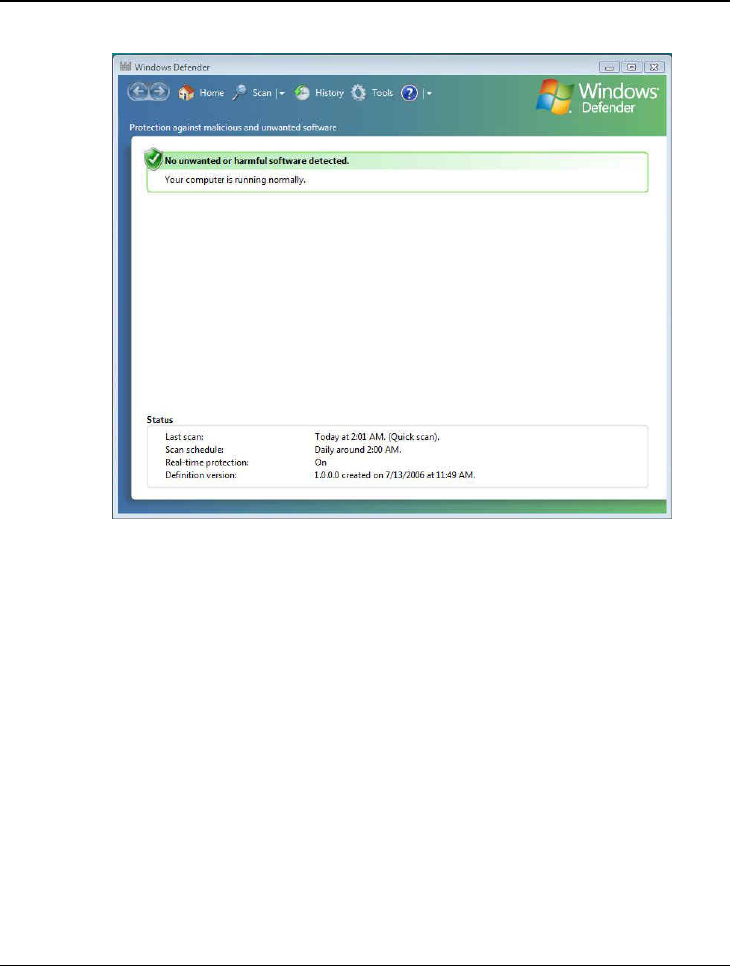
Mini EPC USER GUIDE
54
Windows Defender helps protect computers against pop-ups, slow
performance, and security threats caused by spyware and other
unwanted software. Applications can check and change its status.
Windows DVD Maker
Windows DVD maker helps you burn pictures and video to DVD..
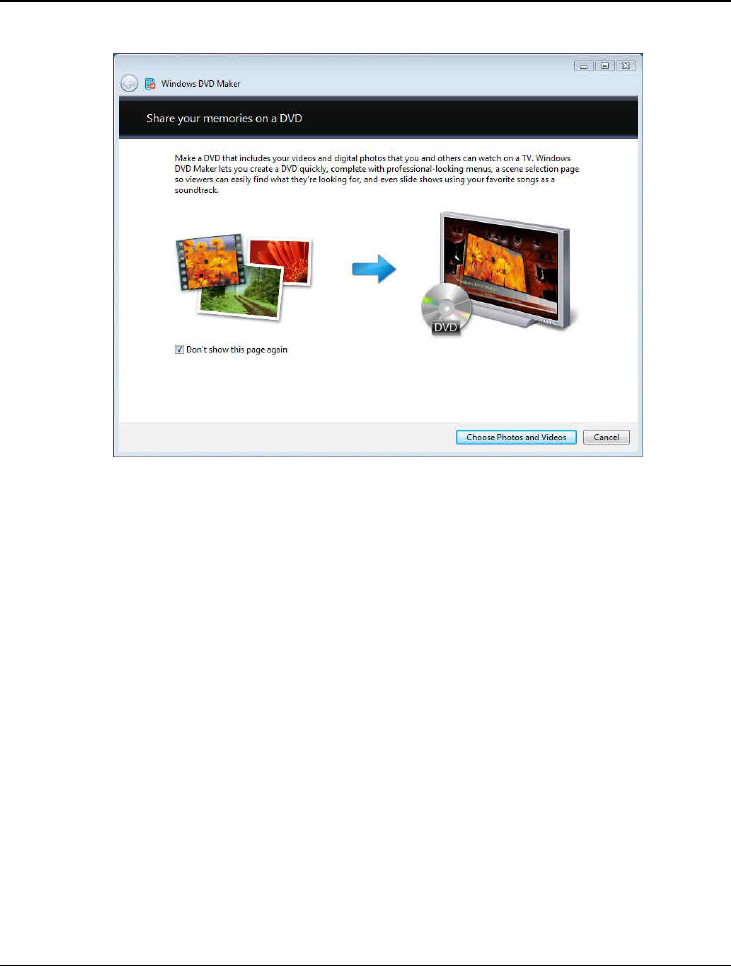
Fun with Windows Vista Experience 4
55
Windows DVD maker lets you create a DVD quickly, complete with
professional-looking menus, a scene selection page so viewers can
easily find what they are looking for, and even slide shows using your
favorite songs as a soundtrack.
Windows Fax and Scan
Windows Fax and Scan help you send and receive faxes or scan
pictures and documents.
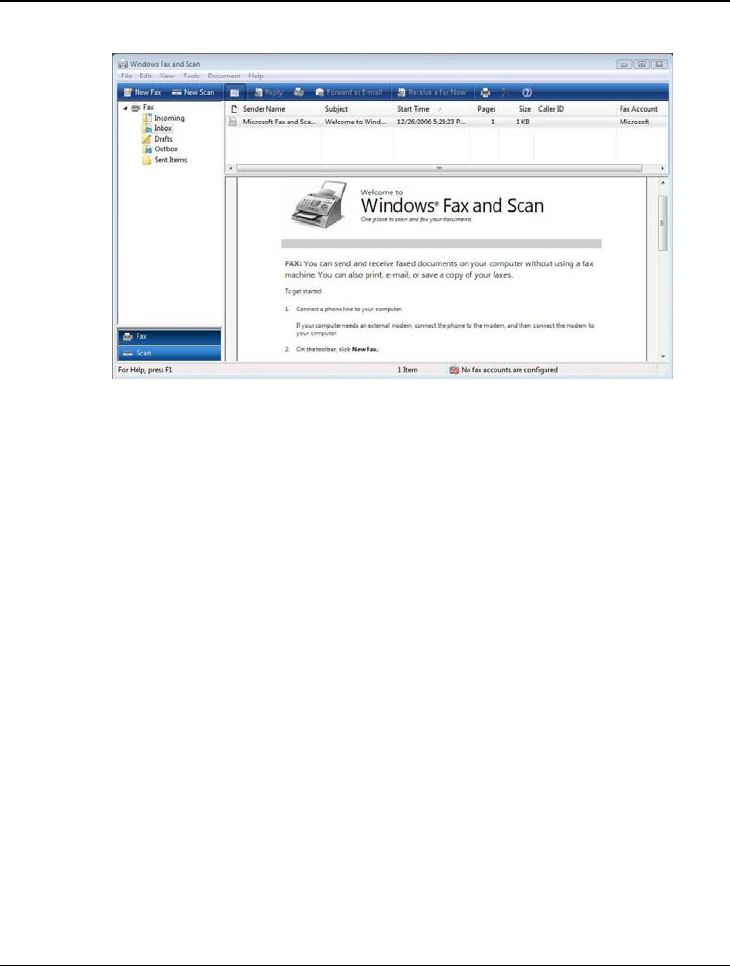
Mini EPC USER GUIDE
56
Faxing and scanning functions come together in Windows Vista
through Windows Fax and Scan. Sending and receiving faxes
through your PC is now as simple as performing the same tasks on a
fax machine, especially for digital document
Windows Live Messenger Download
Windows Live Messenger Download can connect and share
message instantly on the world’s favorite IM service..
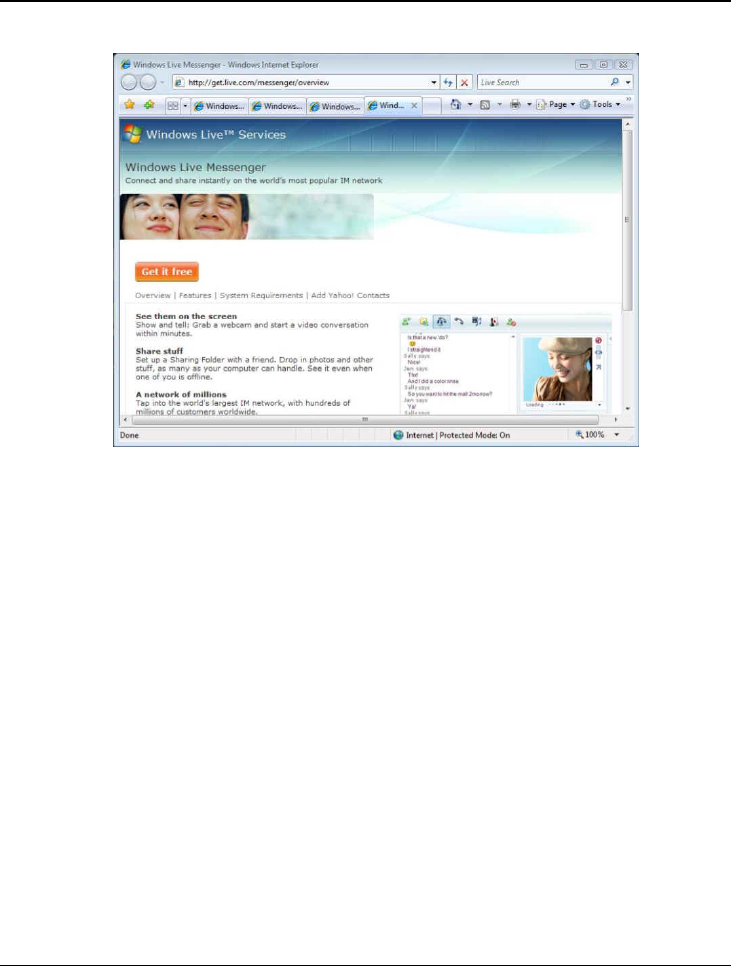
Fun with Windows Vista Experience 4
57
Windows Live Messenger is the next-generation MSN Messenger. It
has everything you already love about Messenger, and much more.
Windows Mail
Windows Mail can send and receive e-mail and newsgroup
messages.
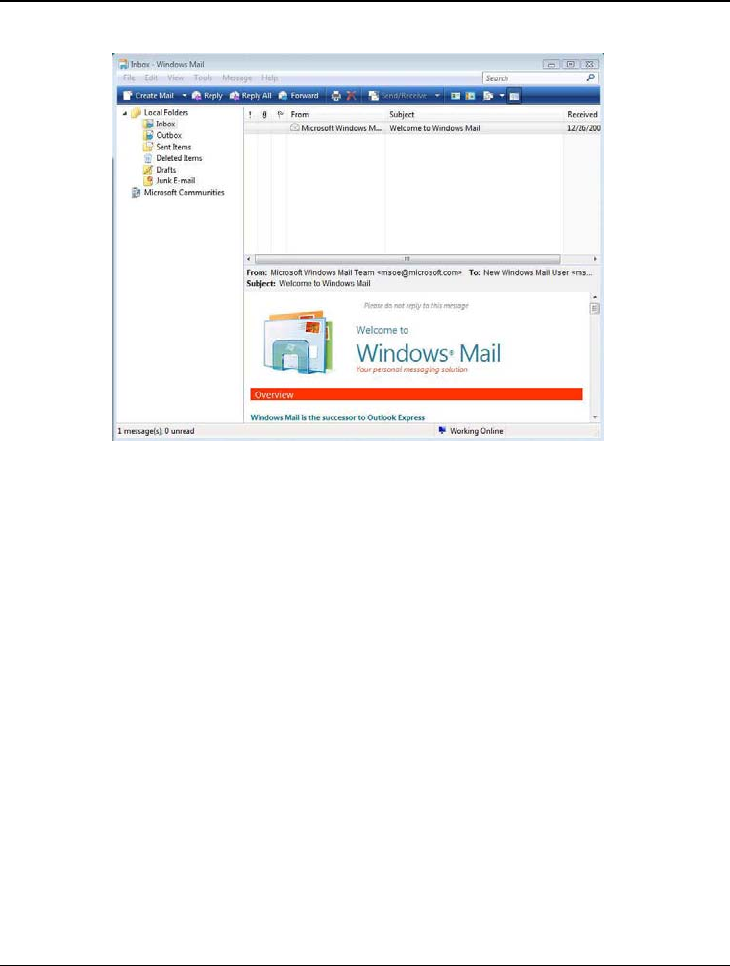
Mini EPC USER GUIDE
58
Windows Mail is designed to help you prevent emerged some
annoyances and risks that have grown over the years, that enables
your e-mail experience is as productive and fun as possible.
Windows Mail includes features that help you reduce the risks, while
enjoying the many benefits, of e-mail
Windows Media Center
Windows Media Center lets you opens your home entertainment
option for digital and on-demand media, including TV, Movies, music
and pictures.
It is enable to make you enjoy all your favorite digital entertainment—
including live and recorded TV, movies, music, and pictures—in one
place with the easy-to-use Windows Media Center menu system and
remote control. Windows Media Center in Windows Vista includes
enhancements for expanded support of digital and high-definition
cable TV, an improved menu system, and the ability to create a
consumer-electronics-quality living-room experience, as well as new
options for multi-room access to your entertainment through Media
Center Extenders.
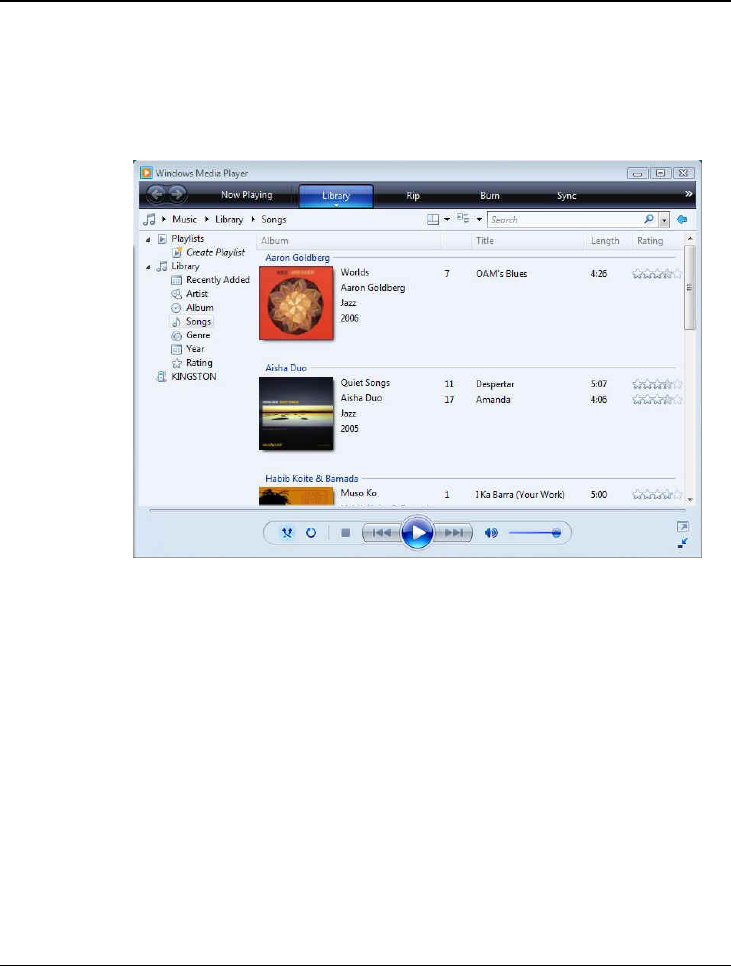
Fun with Windows Vista Experience 4
59
Windows Media Player
Windows Media Player can play digital media including music, video,
CDs and DVDs.
Windows Media Player gives you an easier way to enjoy and
manage your digital music, video, and pictures on your PC. See
things the way you want to see them, by CD cover art or in lists.
Connect to networked media devices around your home or
seamlessly sync up with your portable digital media player to enjoy
all your entertainment wherever you are. Sporting an improved look
and feel, Windows Media Player delivers a high-quality audio and
visual experience both on the computer and around your home
Windows Meeting Space
Windows Meeting Space lets you share files, a program, or your
laptop anytime and anywhere.
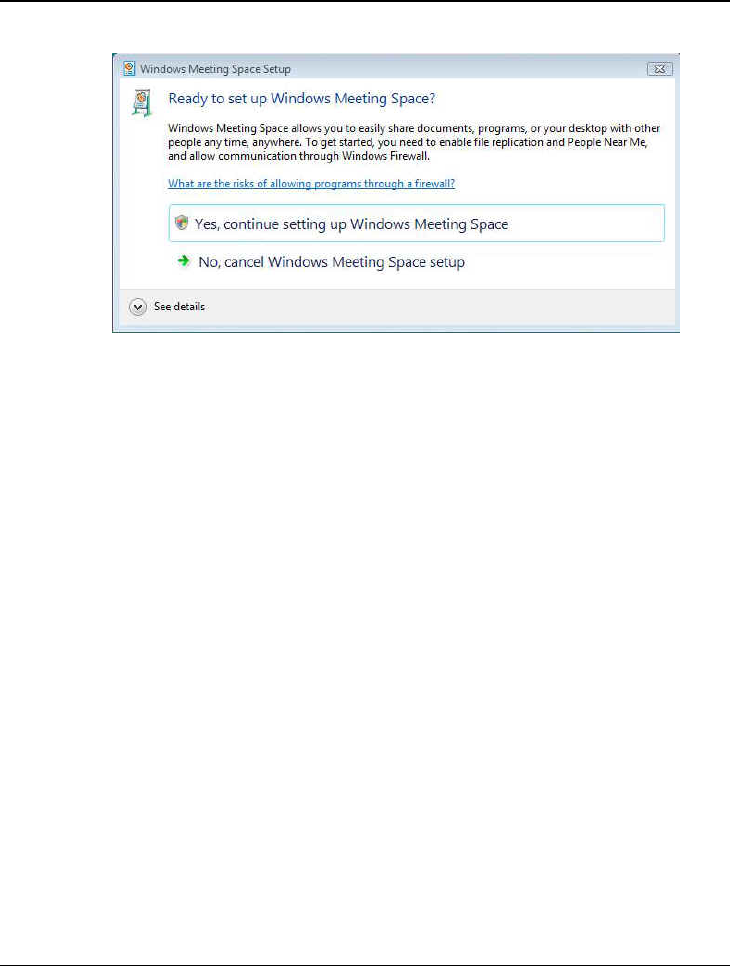
Mini EPC USER GUIDE
60
Windows Meeting Space gives you the ability to share documents,
programs, or your desktop with other people. Some advantages are:
you can share your desktop or any program with other meeting
participants; you and other meeting participants can distribute and
co-edit documents; you can pass notes to other participants; you can
connect to a network projector to give a presentation.
Windows Movie Maker
Windows Movie Maker helps you make your own movie using videos,
digital pictures and movies.
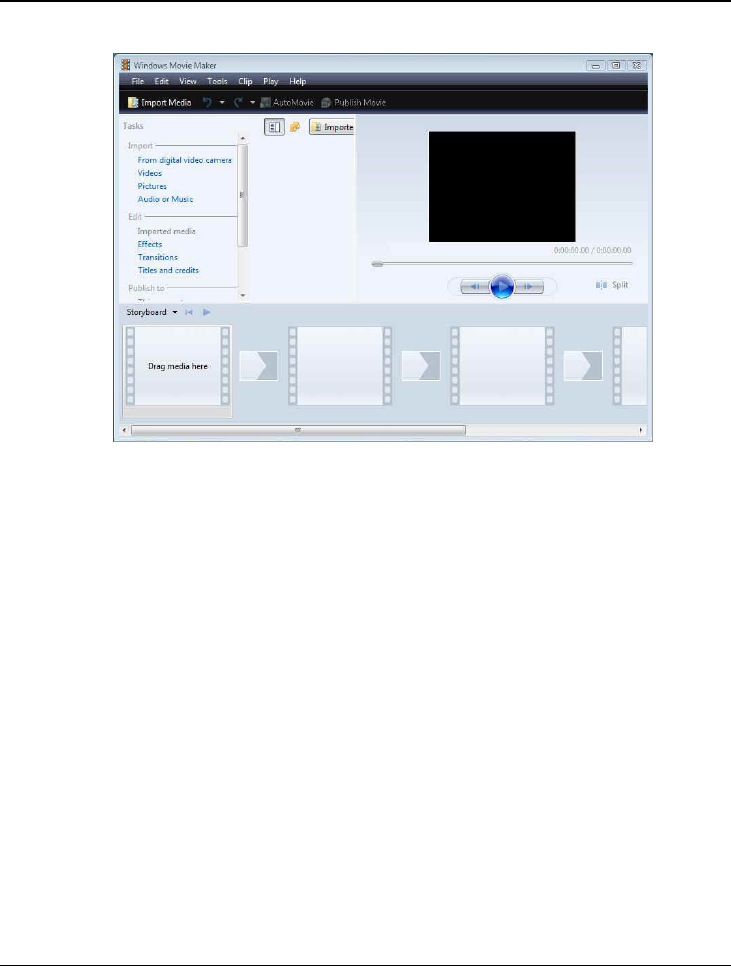
Fun with Windows Vista Experience 4
61
With Windows Movie Maker, you can quickly and easily import, edit,
and organize all of your digital home videos. New tools, such as new
effects and transitions, and improved graphics performance help you
manage and edit your home videos. You can include photos along
with video when you create a movie, and even add narration and
soundtracks. Once your movies are just the way you want them, you
can easily burn them to DVD or share them with others through the
Internet
Windows Photo Gallery
Windows Photo Gallery lets you view , edit, organize, and share your
photos and videos.
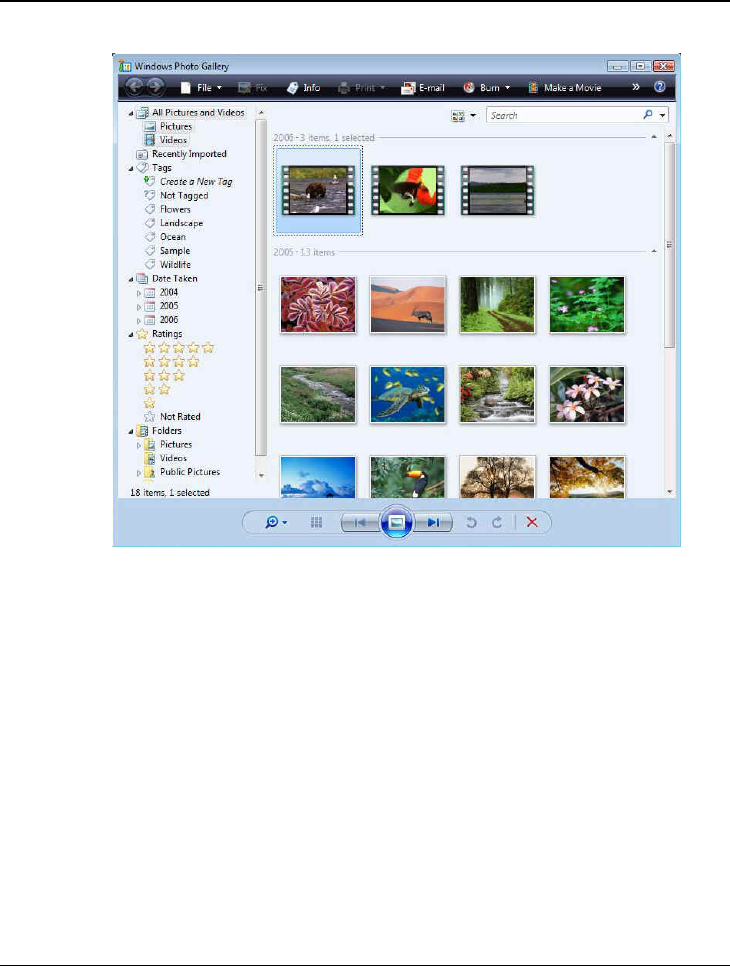
Mini EPC USER GUIDE
62
Windows Photo Gallery in Windows Vista gives you the tools you
need to easily organize, find, and view your photos and videos. You
can edit, print, and share your photos from within Windows Photo
Gallery, as well as transfer photos from your camera to your
computer with a simple import process
Windows Update
Windows Update delivers software updates and drivers, and provide
automatic updating options.
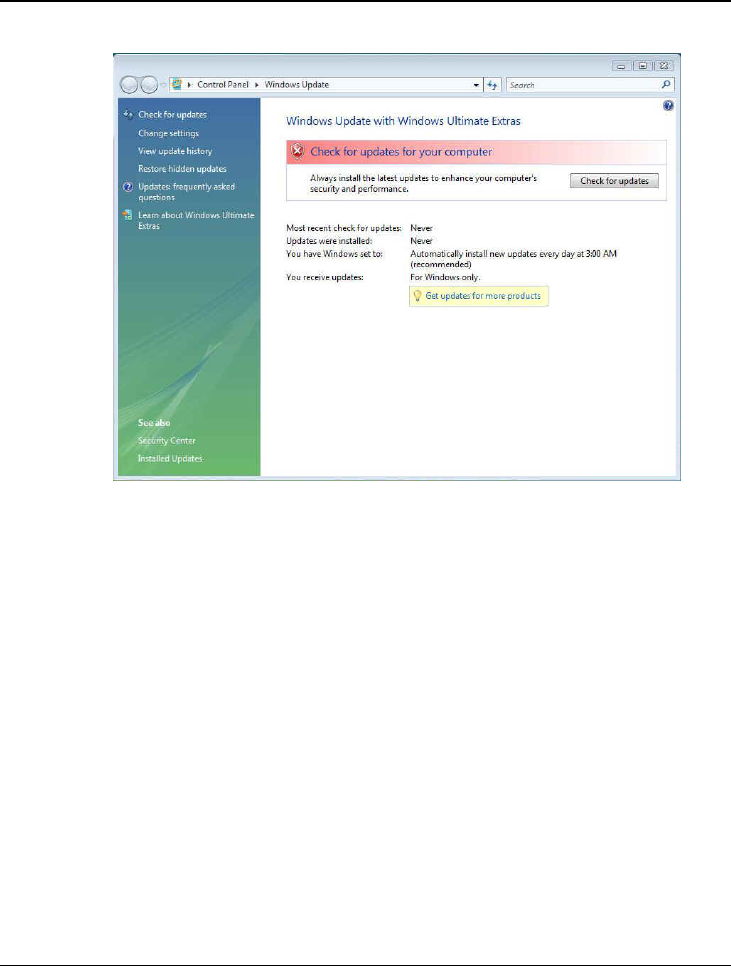
Fun with Windows Vista Experience 4
63
Windows Update keeps your computer up to date and more secure
by automatically providing software updates to Microsoft Windows
Vista. Updates can include upgrades to Windows Vista features,
updates that improve reliability and performance, and updates that
provide new security protections against malware and other
potentially unwanted software.
Windows Update makes updating easy and minimizes disruption to
your work. It's easy to start updating—when you set up Windows
Vista, you can set options that enable Windows Update to
automatically download and install updates for you—so you can "set
it and forget it
Windows Sidebar and Gadgets
As you use your computer to access more information, perform more
tasks, and interact with more software applications, you increasingly
face information overload. You open a web browser just to check the
weather, open an application to view your calendar, and open a
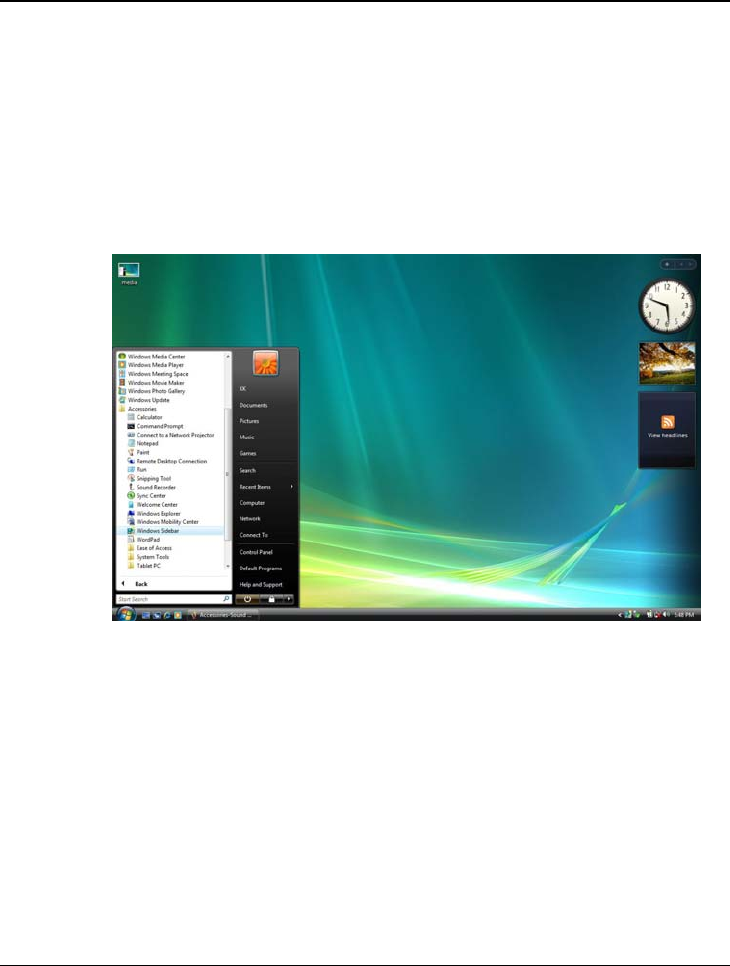
Mini EPC USER GUIDE
64
calculator program to simply add numbers. You need simple,
specialized, and lightweight mini-applications that put information
and tasks at your fingertips—no matter what you're doing.
Windows Sidebar boosts your personal productivity by providing
instant access to gadgets—a wide variety of engaging, easy-to-use,
and customizable mini-applications that offer information at a glance
and provide easy access to frequently used tools
Gaming
If you are a parent, you now have a rich set of controls to ensure
your children are only playing games that you consider appropriate.
You can allow or restrict your children's access to games according
to game title, rating, category, or content. Windows Vista supports six
international rating standards and makes it easy for parents to
manage and monitor their children's gaming experience
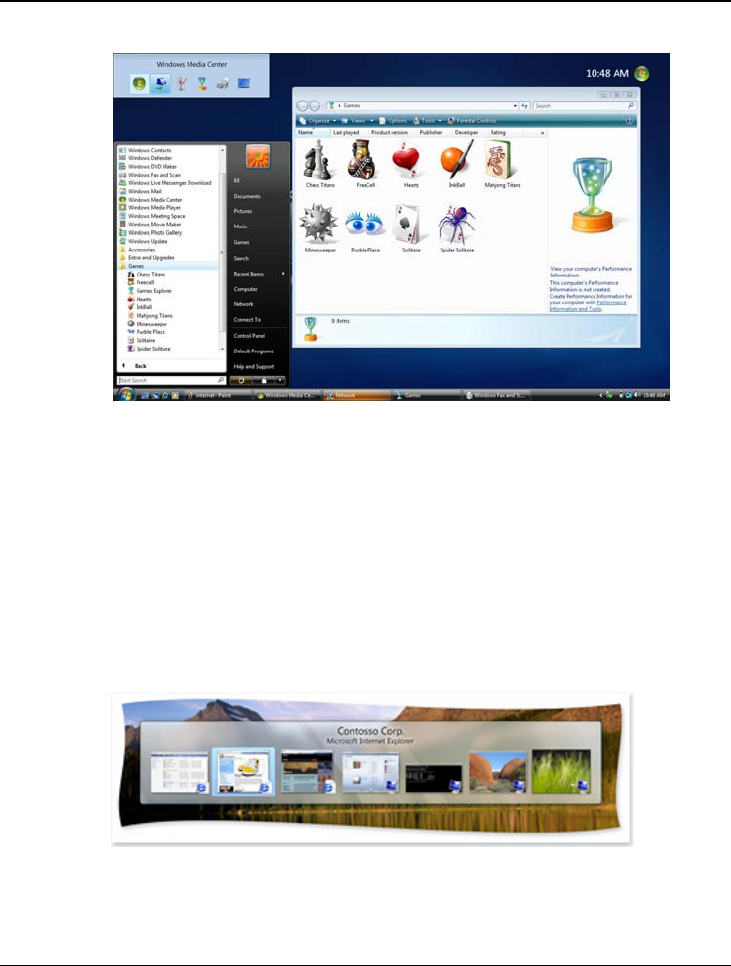
Fun with Windows Vista Experience 4
65
Windows Flip and Windows Flip 3D
Windows Vista provides two entirely new features to manage
windows: Windows Flip and Windows Flip 3D. Flip allows you to flip
through open windows (by using Alt+Tab), providing a live thumbnail
of each window, rather than just a generic icon and file name. Live
thumbnails make it easier to quickly identify the window you want,
particularly when multiple windows of the same kind are open. With
Flip 3D, you can use the scroll wheel on your mouse to flip through
open windows in a stack, and quickly locate and select the one you
want to work with.
Use Flip to view and navigate more easily through open windows.

Mini EPC USER GUIDE
66
You can visit and browse each domain to experience the information
and assistance that Windows Vista offers.
For more information, please refer to Microsoft’s website:
http://www.microsoft.com/windowsvista/features/default.mspx

Connecting to Peripherals 5
67
5 Connecting to Peripherals
This chapter describes how you attach peripheral devices to your
mini EPC. You can attach a printer or mouse; connect an external
monitor and keyboard, or any other peripheral device.
5.1 Using the USB Port
USB (Universal Serial Bus) is a hardware interface that enables you
to connect multiple devices (such as mouse, keyboard, storage
device, joystick, digital camera, and video conference cameras, etc.)
to your mini EPC. Besides, USB’s hot swap capability allows
everything to be plugged in and unplugged without turning the
system off.
Microsoft, HP, Compaq, Intel, Agere, NEC and Philip are seven core
members of USB-IF to have worked on USB 2.0 standardization.
USB 2.0 offers data transfer rate up to 480Mbps (megabits per
second) compared to USB 1.1 devices, which transfer at speeds of
12Mbps. So, you could know that USB 2.0 can transfer data between
the mini EPC and its peripherals 40 times faster than USB 1.1.
However, USB 2.0 is fully backward compatible, you will be able to
use a USB 1.1 device in a USB 2.0 compliant system.

Mini EPC USER GUIDE
68
5.2 Using the LAN Port
This mini EPC is equipped with an internal 10B /100/1000Base-T
Gigabit Ethernet LAN module that connects your mini EPC to other
mini EPC/networks through a local area network (LAN) and supports
data transfer rates at 10/100Mbps and can be up to 1000Mbps. The
100Base-TX is called Fast Ethernet.
To meet higher bandwidth demand, this mini EPC has upgraded Fast
Ethernet to Gigabit Ethernet. The network becomes more efficient
while downloading movies, music or other multimedia files.
The built-in Gigabit Ethernet LAN module provides a standard RJ-45
connector.
5.3 Using the IEEE 1394 Port
IEEE 1394, also known as FireWire, is a high-bandwidth serial bus
developed by Apple and Texas Instruments. IEEE 1394 supports
100, 200, and 400 Mbps (Megabit per second) transfer rates and is
widely used for downing video from digital camcorders to the mini
EPC. In addition to its high speed, IEEE 1394 enables isochronous
(real-time) data transfer. This makes it ideal for devices that transfer
high-bandwidth of data in real-time, such as video devices. It
supports both Plug-and-Play and hot plugging, and also allows for
the connection of up to 63 devices.
With built-in IEEE 1394 port, this mini EPC enables the peripheral
devices in transmitting digital video data or data backup. The
Windows system will automatically recognize it after installing a
suitable driver for it. Please visit Microsoft's web site for more

Connecting to Peripherals 5
69
information about it. Moreover, you should install the driver of
peripheral device to connect with the IEEE 1394 port, for details
please refer to the manual that comes with your peripheral device.
5.4 Using the AV-in Port (optional)
AV-IN is the function that TV tuner offers, like the function of Video
Recorder that allows audio-visual signals to be received by your Mini
EPC. No matter TV programs and other media sources such as DVD
player, DSC/DV, Hi8, D8 or video recorder, you can record or play
whatever you want.
You can transmit the video and audio signals via AV in port into TV
tuners as video capture cards to record the programs or film onto a
hard disk, with installing its collocate software, you are allowed for
audio-visual editing.
To use the AV-in port, you should install the third party application
like Cyperlink PowerCinema 5 first, then connect the DVD player, DV
consume electronic device, etc….with AV_in cable into GE3 AV_in
port.
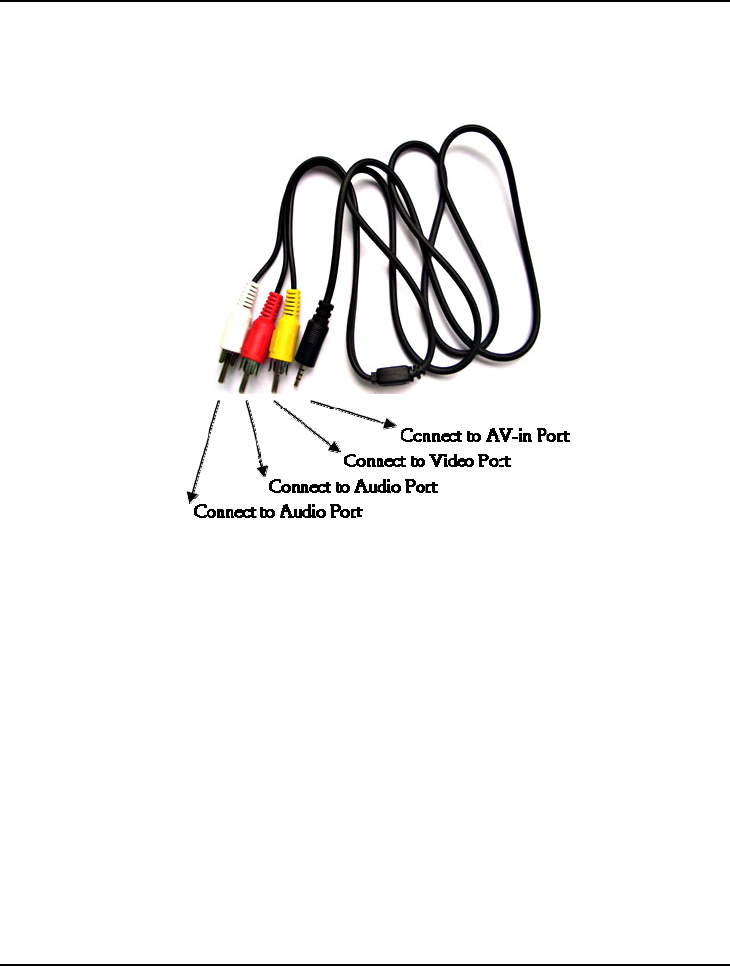
Mini EPC USER GUIDE
70
AV-in Cable
When an AV connection cable is used for connection through the
AV-in port, the mini EPC automatically detects the video signal of the
connected device. You can view the video on the screen simply by
starting playback on the connected device.
Mini EPC gives you the most intact video recording and editing
function for you when watch other types of your peripheral device to
connect your mini EPC via the AV-in port.
For detailed, please refer to the instruction manual for your video
equipment and the instructions supplied with the AV connection
cable on how to connect your device to the mini EPC.

Connecting to Peripherals 5
71
The TV-Tuner only can function with Intel® Core 2TM Duo.
The AV-in function is optional, it only is available with installing the
third party application.
5.5 Using the Wireless LAN
Access Point (AP) is the wireless transmission and receiving device,
it generally connects to the server of a LAN environment or act as a
LAN hub with wireless connection. Access point can be set in an
office environment, airport, major railway station, etc. that depends
on the construction of each country. In most case, you probably can
use it at office, please consult with the network department of your
company for more details.
IEEE 802.11b standard supports 11 Mbps wireless connection
speed. However, IEEE 802.11g supports 54Mbps wireless
connection speed, and is backward compatible with the slower
802.11b. Using the orthogonal FDM (ODFM) transmission method.
The higher operating frequency means a shorter transmission radius
(about 60 feet). Wireless LAN module is similar to LAN module. You
need to install software driver before using it. Please refer to chapter
2.5 on how to install the driver.
5.6 Using the Modem Port
This mini EPC comes equipped with a 56Kbps v.92 Data/Fax MDC
1.5 (Azalia) Modem that allows you to communicate with others via
fax, email, or to connect to an online service or bulletin board. The

Mini EPC USER GUIDE
72
built-in fax/data modem provides standard phone connector (RJ-11
connector).
NOTE: For electrical safety concerns, only use telephone cables
rated 26AWG or higher.
When using your telephone equipment, basic safety precautions
should always be followed to reduce the risk of fire, electric shock
and injury to persons, including the following:
1. Do not use this product near water, for example, near a bath tub,
wash bowl, kitchen sink or laundry tub, in a wet basement or
near a swimming pool.
2. Avoid using a telephone (other than a cordless type) during an
electrical storm. There may be a remote risk of electric shock
from lightning.
3. Do not use the telephone to report a gas leak in the vicinity of the
leak.
4. Use only the power cord and batteries indicated in this manual.
Do not dispose of batteries in a fire. They may explode. Check
with local codes for possible special disposal instructions.

BIOS Setup 6
73
6 BIOS Setup
Your mini EPC also uses the Phoenix BIOS Setup program that
allows you to set several system configurations in changing the way
your mini EPC performs. This includes your system time and date,
disk drive configuration and password setup. This information is then
stored in the CMOS RAM and will remain permanent unless you
change it again.
6.1 Running the BIOS Setup Program
Your mini EPC is likely to have been properly setup and configured
by your dealer prior to delivery. However, you may find it necessary
to use the mini EPC’s BIOS (Basic Input-Output System) Setup
program to change system configuration information, such as your
hard disk drive type. The Setup program can be accessed when you
power on the system and pressing the <F2> function key.
As the POST (Power-On Self Test) executes during the boot up
process, the screen will display the following message:
Press <F2> to Enter SETUP
Press the <F2> key to run the BIOS Setup program. The BIOS Setup
program is organized into five menus which you can select using the
Å and Æ keys. To move from one option to another, you use the <+>
and <-> keys to change the settings. On the right hand side of the
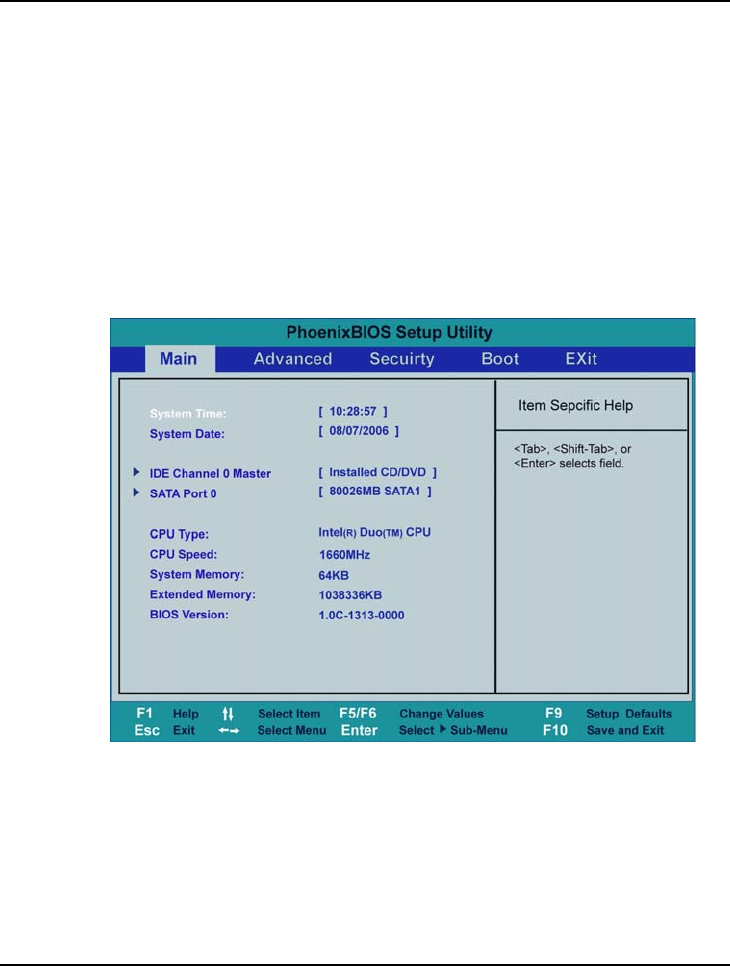
Mini EPC USER GUIDE
74
screen are some brief help descriptions of each item you want to
change.
To exit the BIOS Setup program, simply press the <Esc> key and
select from the Exit menu whether you want to save changes and
exit; discard changes and exit.
6.2 Using the Main Menu Setup
• System Time
Allows you to change the system time using the hour: minute:
second format of the mini EPC.
You can also change the system time from your operating
system.

BIOS Setup 6
75
• System Date
Allows you to set the system date using the month/date/year
format.
You can also change the system time from your operating
system.
• IDE Channel 0 Master
This field displays various parameters for the hard disk drive. If
type [Auto] is selected, the system automatically sets these
parameters. If type [User] is selected, Cylinders, Heads and
Sectors and other value can be edited.
• SATA Port 0
This field is for information only as the BIOS automatically
detects the optical drive.
• CPU Type
This field reports the CPU type information detected by the BIOS
during Power-On Self-Test (POST).
• CPU Speed
This field reports the CPU speed information detected by the
BIOS during Power-On Self-Test (POST).
• System Memory
This field reports the amount of base (or conventional) memory
found by the BIOS during Power-On Self-Test (POST).
• Extended Memory
This field reports the amount of extended memory found by the
BIOS during Power-On Self-Test (POST).
• BIOS Version
This field is for information only as the BIOS displays the BIOS
version during the Power-On Self-Test (POST).
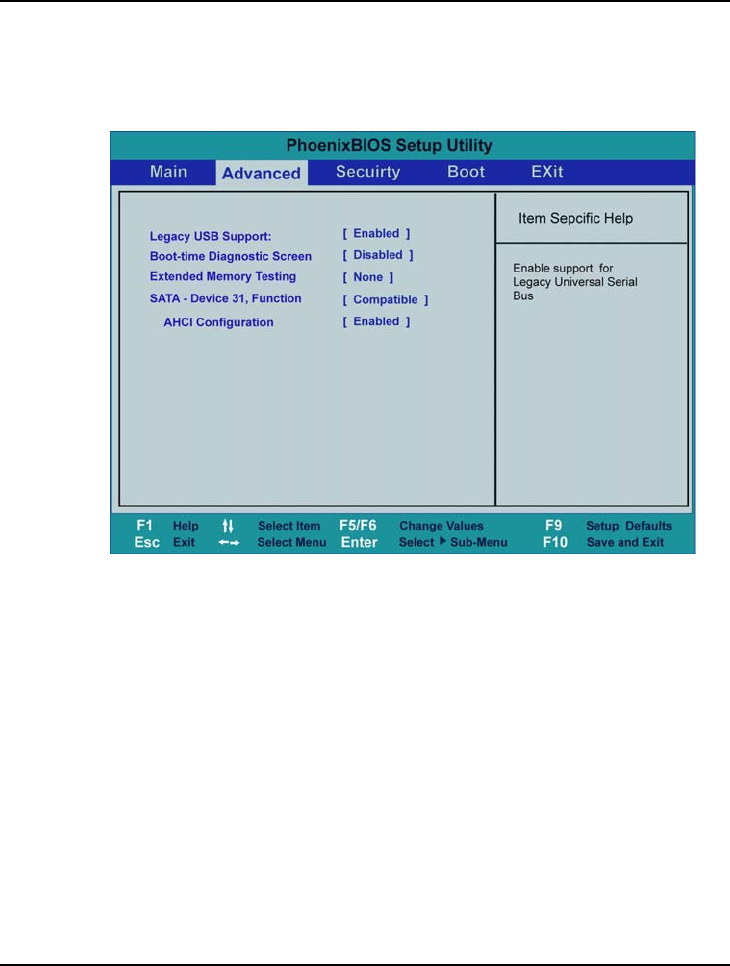
Mini EPC USER GUIDE
76
6.3 Using the Advanced CMOS Setup
• Legacy USB Support
Enable or disable the USB Bus support when in connection with
USB device.
• Boot-time Diagnostic Screen
Lets you display or not display the diagnostic screen by choosing
Disabled or Enabled.
• Extended Memory Testing
Determines which type of tests will be performed on extended
memory (above 1M).
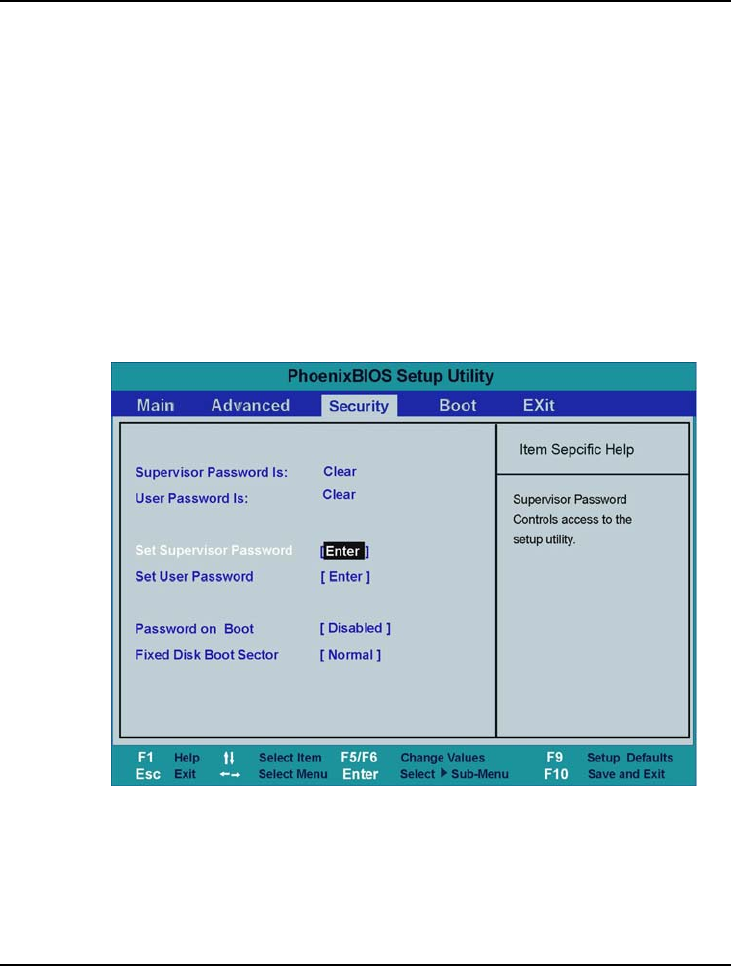
BIOS Setup 6
77
• SATA – Device 31, Function
This function lets you choose “Compatible” or “Enhanced” to
define the SATA or PATA controller mode. For enabling the AHCI
configuration, you should choose “Enhanced” option first.
• AHCI Configuration
Lets you choose “Enabled” or “Disabled” to activate or inactive
the AHCI mode for Windows Vista driver.
6.4 Security Menu Setup
• Supervisor Password Is
Set/Clear selections show that the mini EPC is under controlled
by Supervisor Password or not.

Mini EPC USER GUIDE
78
• User Password Is
Set/Clear selections show that the mini EPC is under controlled
by User Password or not.
• Set Supervisor Password
Supervisor password gives you the authority in accessing the
setup utility. You also need to enter this password in system
booting and resuming from suspend mode. When you press
<Enter> in this field, the Set Supervisor Password dialog box
appears. Enter a new password with up to 8 alpha-numeric
characters, and then re-enter it for confirmation.
• Set User Password
This field is only available when Supervisor Password has set.
Enter the user password when boot the system or resume from
suspend mode. But if the Write Protect is set in the Fixed disk
boot sector field, you should enter a supervisor password to
access the fixed disk when boot the system or resume from
suspend mode.
• Password on Boot
If you set this field to Enabled, your mini EPC will always ask for
the password every time you boot your mini EPC.
• Fixed Disk Boot Sector
If you set this field to Write Protect, the write protect boot sector
on hard disk will protect against viruses. In this situation, only the
supervisor can access the Boot Sector of fixed disk.
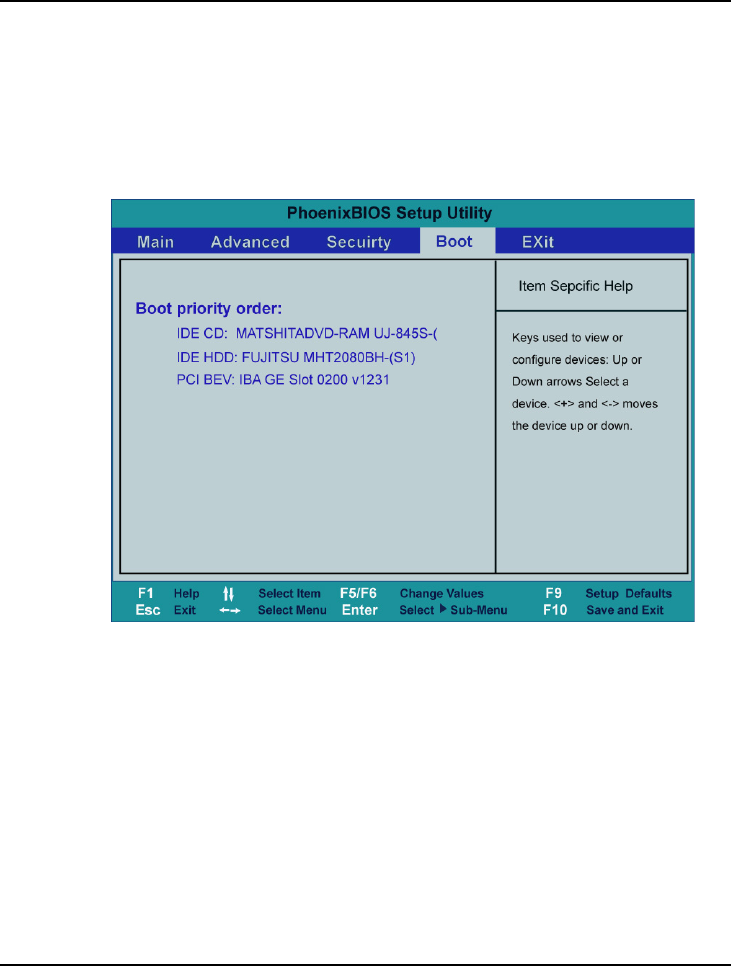
BIOS Setup 6
79
6.5 Using the Boot Setup
This item allows you to set the search drive sequence where the
system will try to boot up first.
This page allows you to set the search drive sequence where the
system will try to boot up first.
To select the boot device, you can use the up or down arrow key,
then press <+> to move up the device in the list or press <-> to move
down the device in the list. To exit from this menu, press <Esc>.
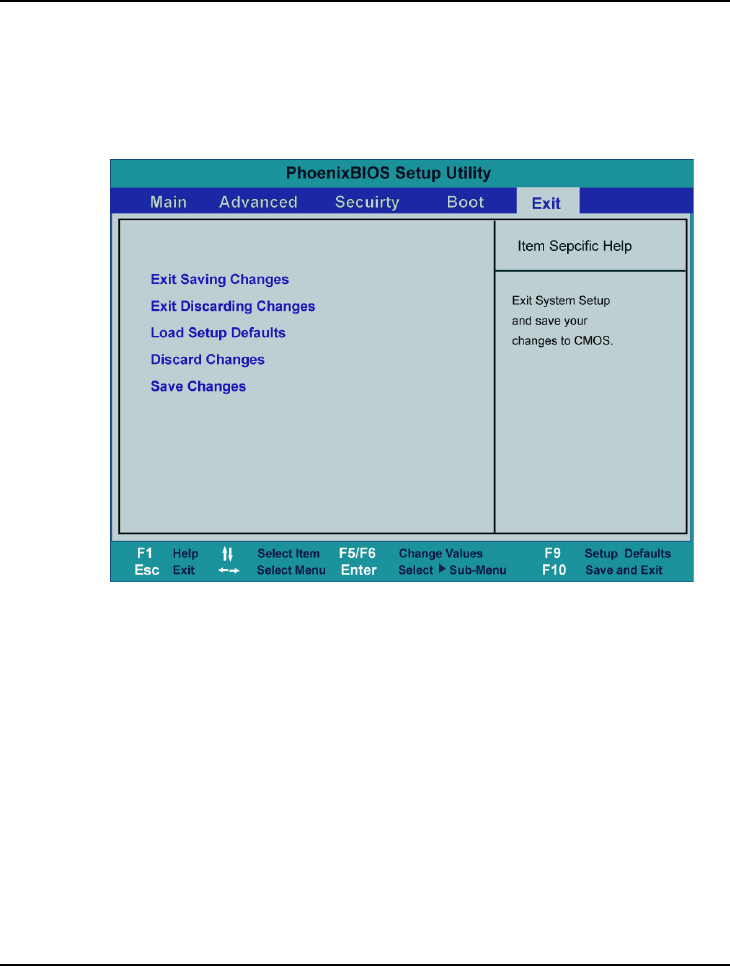
Mini EPC USER GUIDE
80
6.6 How to Exit the Setup Program
There are two choices to escape from the Setup program.
• Exit Saving Changes
Saves all changes to CMOS while running the BIOS setup
program and exit from the system setup program.
• Exit Discarding Changes
Allows you to discard all changes made while running the BIOS
setup program and exit from the system setup program.
• Load Setup Defaults
Lets you load the default values for all setup items.
• Discard Changes
Reverts to previously selected settings.
• Save Changes
Saves Setup data to CMOS.

Caring for Your Mini EPC 7
81
7 Caring for Your mini
EPC
Important Safety Instructions
This section gives you detailed information about how to maintain a
safe environment while using the mini EPC. You can maintain its
condition and performance by following these guidelines. Please read
it carefully to ensure maximum safety.
• Lay the mini EPC on a reliable surface when installing. A drop or
fall may cause injury.
• The Air-Outlet Vents on both sides of this mini EPC are for air
convection hence the mini EPC can be protected from
overheating. DO NOT COVER THE AIR-OUTLET VENTS.
• Never open the body of mini EPC. For safety reason, the mini
EPC should only be opened by qualified service personnel.
Environment
• Please keep the mini EPC from humidity.
• Use only a power adapter approved for use with this mini EPC.

Mini EPC USER GUIDE
82
• Though your AC adapter is suitable for universal international
voltage, it still requires a stable and continual power supply.
Make sure the voltage of the power source is suitable when
connect the mini EPC to the power outlet. If you are unsure of
your local power specifications, consult your dealer or local
power company.
• Do not leave this mini EPC in an environment unconditioned.
Storage temperature above 60ºC (140ºF) may damage the mini
EPC.
Power Supply
• All cautions and warnings on the mini EPC should be noted.
• The power adapter may have a 3-prong plug. This is an
important safety feature. A compatible outlet is required. If it is
not available, find a qualified electrician to install one.
• While unplugging the power cord, disconnect it by the plug head,
not by its wire.
• Make sure the socket and any extension cords you may use can
support the total current load of all the connected devices.
• If the mini EPC is not in use for a long time, disconnect it from
power supply to avoid possible damage by transient over-
voltage.
• To avoid any damage happened to the internal device, you
should first disconnect the AC adapter when replacing any
internal device.

Caring for Your Mini EPC 7
83
Cleaning Your Mini EPC
When it is necessary to clean the plastic case, use a soft, lint-free
cloth, slightly dampened with a mild detergent solution. When
cleaning, do not use liquid or sprayed detergent for cleaning. Instead,
use moisture sheet or a cloth for cleaning.
Never use alcohol, petroleum-based solvents, or harsh detergents to
clean the mini EPC. Also never spray any liquids directly on the mini
EPC case, keyboard, or screen.
Maintaining Hard Disk
Here is some maintenance you could do:
• Install the antivirus program to monitor virus that could hacker
your files.
• Use SCANDISK once in a while to correct any errors found in the
directory and File Allocation Table. This will also free up space
from any unused sectors.
• Use hard disk maintenance programs like Disk Defragmenter of
Windows. These reorganize your hard disk by eliminating
fragmentation and improving your hard disk access time.
• Install a system password in your mini EPC so others won't be
able to use the hard disk.

Mini EPC USER GUIDE
84
This page is intended to be blank.
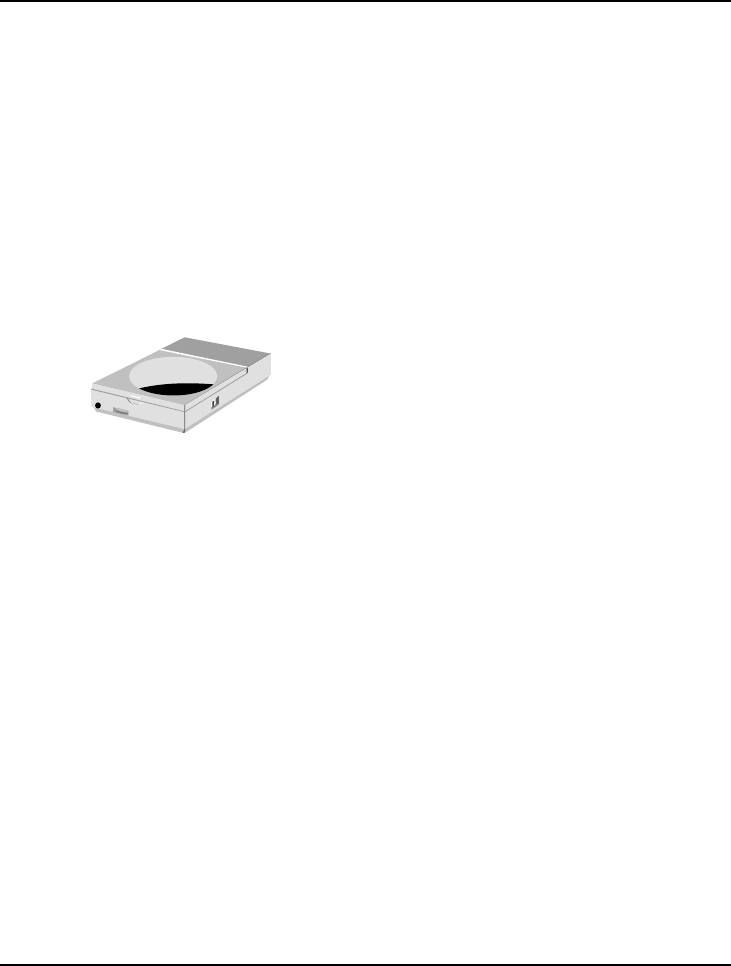
System Specifications A
85
APPENDIX A
System Specifications
This appendix gives information on the
technical and hardware specifications of your
mini EPC. Please note that the information
mentioned here may not be exactly the same
with your mini EPC as specification is subject to
change without notice or modifying this manual.
Designed with an advanced modular
architecture, your mini EPC also allows you for
several levels of customization and expansion
that are previously available only on desktop
PCs.

Mini EPC USER GUIDE
86
System Specifications
PROCESSOR UNIT
z Intel® Core™ 2 Duo or Celeron ® processor (Santa Rosa)
z 4MB or 2MB integrated L2 cache
SYSTEM MEMORY
z Two 200-pin memory slots
z User-upgradeable to maximum 4GB using 200-pin SODIMM 512MB,
1024MB or 2048MB modules
z DDR2–667 SDRAM modules
STORAGE
z 2.5” Format 9.5mm High SATA HDD Module; Bus Mastering, Ultra
DMA ATA-150 Support for LBA Scheme
z Fixed Slot-in DVD-Multi /Combo
VIDEO
z Embedded in Intel GM965 sharing with main memory
z 85 Hz Refresh Rate: Max. 1600 x 1200 pixels, up to 32bit Colors
WIRELESS USB KEYBOARD
z 99 Keys (including hot-key) with Track Ball (mouse) function
z Distance for remote control: within 5m
z Frequency for signal transmitted: at 2.4GHz

System Specifications A
87
AUDIO
z Sound Codec chip: Azalia ALC268
z Compliant with Intel HD Audio
I/O PORTS
z One DVI-I Socket
z One AV-In Port
z One TV Port (S-Video)
z Three USB2.0 Ports at rear side
z One USB2.0 Port at front side
z 4 in 1 Card Reader (for SD, MS, MMC & MS Pro) Socket
z One DC-in Jack
z One IEEE 1394 Port
z TV-Tuner Port (Option)
The TV-Tuner only function with Intel® Core 2TM Duo.
z External CIR Remote Control
z One Headphone/Line Out Jack shared with SPDIF out
z One Microphone/Line in Jack
COMMUNICATION
z Built-in 10/100/1000Base-T Ethernet Giga-LAN
z 56Kbps v.92 Data/Fax MDC 1.5 (Azalia) Modem Module (Option)
WIRELESS
z USB Interface
z External Bluetooth Headphone, Keyboard & Mouse

Mini EPC USER GUIDE
88
z Offers a wireless connection radius of 32.8 feet (10 meters) to other
Bluetooth devices.
z WLAN card with third party is available
Power System
z Adapter, AC 100-240Volt, 50-60 Hz, 65W, 20 Voltage or Less
OPERATING SYSTEM
z Windows Vista
WEIGHT AND DIMENSION
z 226mm (W) x 172mm (D) x 42mm (H)
z Approximately 1.3kg